
When Apple surprises me, it doesn’t tend to be some flashy feature that blows the rest of the world away. Instead, it tends to be them doing something slightly out of their usual swim lane, or their norms. For example, adding in running efficiency metrics a few years ago. This year, that surprise goes to the AirPods Pro 3 team in delivering mind-bogglingly good heart rate accuracy. Like, I won’t beat around the bush: After the dismal accuracy in the PowerBeats 2 Pro earlier this year, this is an astonishing turnaround. But let’s not get ahead of ourselves.
The AirPods Pro 3 have plenty of new features when it comes to sound quality, noise reduction, and more. But more importantly to this site, are all of the sports and fitness features they’ve added. This includes adding heart rate sensing to the tiny little buds in order to measure your heart rate, along with a new feature in the Apple Fitness app to record your workout (including GPS data from your phone), as well as the ability to have Apple’s new Apple Intelligence-enabled Workout Buddy feature.
At the same time, while they had the PowerBeats 2 Pro base to work from, much has changed here – and some features have even been removed. The choice might not be as clear-cut as you think. So, let’s dive into all the details.
Note that Apple has provided a loaner set of AirPods Pro 3’s, though I’ve already ordered my own. Heck, setting aside any fitness aspects, I just want them for the vastly improved noise cancellation. As someone who spends a ton of time on airplanes, that alone is worth it for me. In any case, once I’m done with these, they’ll go back to Apple.
With that, let’s quickly recap what’s new, and then crack open the box.
What’s New:
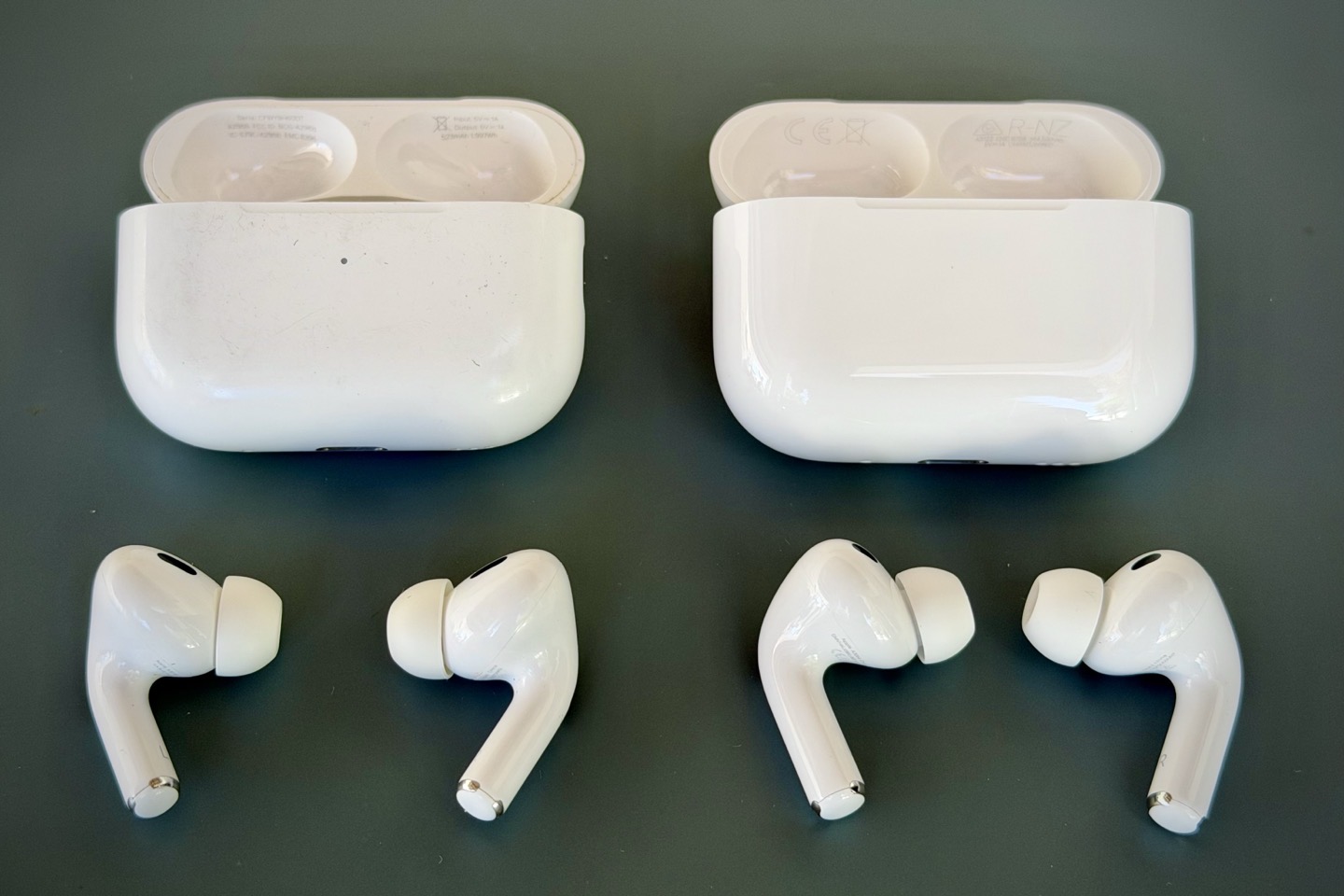
(Above left – AirPods Pro 2, right – AirPods Pro 3)
Visually speaking, as seen above, the AirPods Pro 2 and the AirPods Pro 3 look almost identical. But almost is the key word. Here’s a quick-hit list of the differences between the AirPods Pro 2 vs Pro 3 models
– Added heart rate sensing (in-ear)
– AirPods Pro 3 has 2x more noise cancellation than AirPods Pro 2 (and 4x more than AirPods Pro 1)
– Apple says they changed internal airflow components, which improves transparency mode & Adaptive EQ
– Changed overall design to make this smaller, improving fit
– Changed eartip design to be ‘foam-infused’, which means it basically fits/stays put better
– Added 5th included eartip size (added XXS, also includes XS, S, M, L sizes)
– Updated to Apple’s U2 (Ultra Wideband) chip for better FindMy support (previous was U1 chip)
– Increased water resistance spec from IP54 to IP57
– Increased battery life in ANC mode from 6hrs to 8hrs
– Increased battery life in transparency mode from 6hrs to 10hrs
– Increased battery life for hearing aid mode from 6hrs to 10hrs
– Reduced overall case charge from 30hrs to 24hrs
– Now records steps/move/calories to the Apple Fitness app (and your rings) during a workout
In addition, there are a few features that were announced with the AirPods Pro 3’s that will also be coming to the AirPods Pro 2:
– Added Live Language Translation
– Expanded Fitness app to include Live HR recording with AirPods Pro 3 (and all HR sensors)
– Expanded Fitness app to include AI Workout buddy feature with AirPods Pro 3 (and all headphones)
– Expanded Fitness app to include live recordings of workouts (AirPods Pro 3 unlocks much longer list of workout types)
– Included ability to do sensor fusion between Apple Watch & AirPods Pro 3 for heart rate data (best 5-minute rolling average selected)
– Added ability to use as a camera remote for your phone
Finally, when it comes to the PowerBeats Pro 2, I want to note two key differences that the AirPods Pro 3 lack:
– No Android configuration app on the AirPods Pro 3 like there was on PowerBeat 2 Pro
– No broadcasting of heart rate on standard Bluetooth HR profiles, like there was on PowerBeat 2 Pro
– And thus, no gym equipment/fitness machine support, like there was on PowerBeat 2 Pro
Ok, with all that noted, the price remains the same at $249USD on the AirPods Pro 3, which is very much appreciated in a year when prices increased everywhere, primarily for tariffs, but also overall inflation.
In The Box:
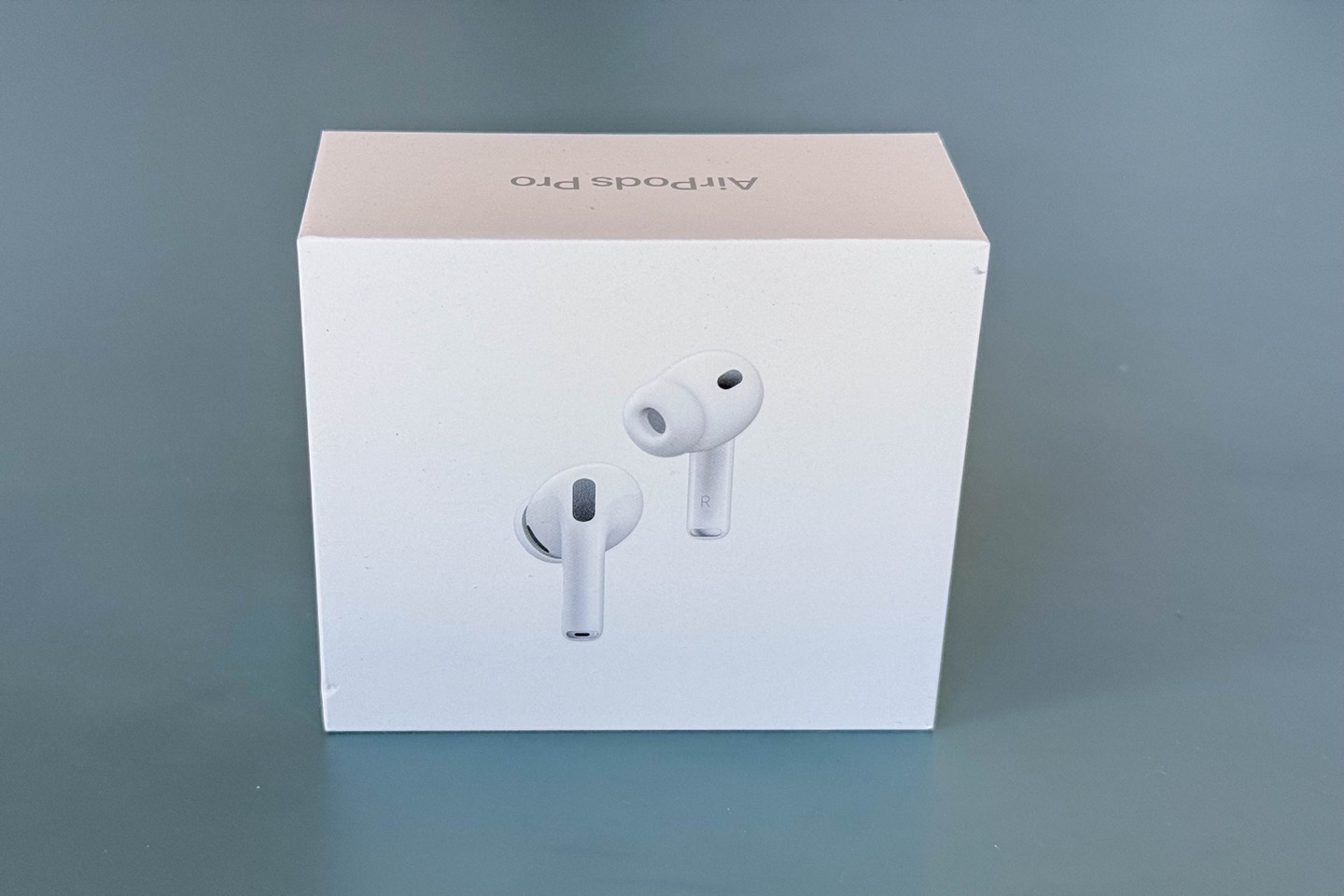
Here’s a quick tour of what you’ll find in the box. First up, here are all the pieces at a high level:

And then the close look at the ear tips. Note the expansion to include an XXS one, in addition to the existing sizes of XS, S, M, and L (the Medium is on the units already):
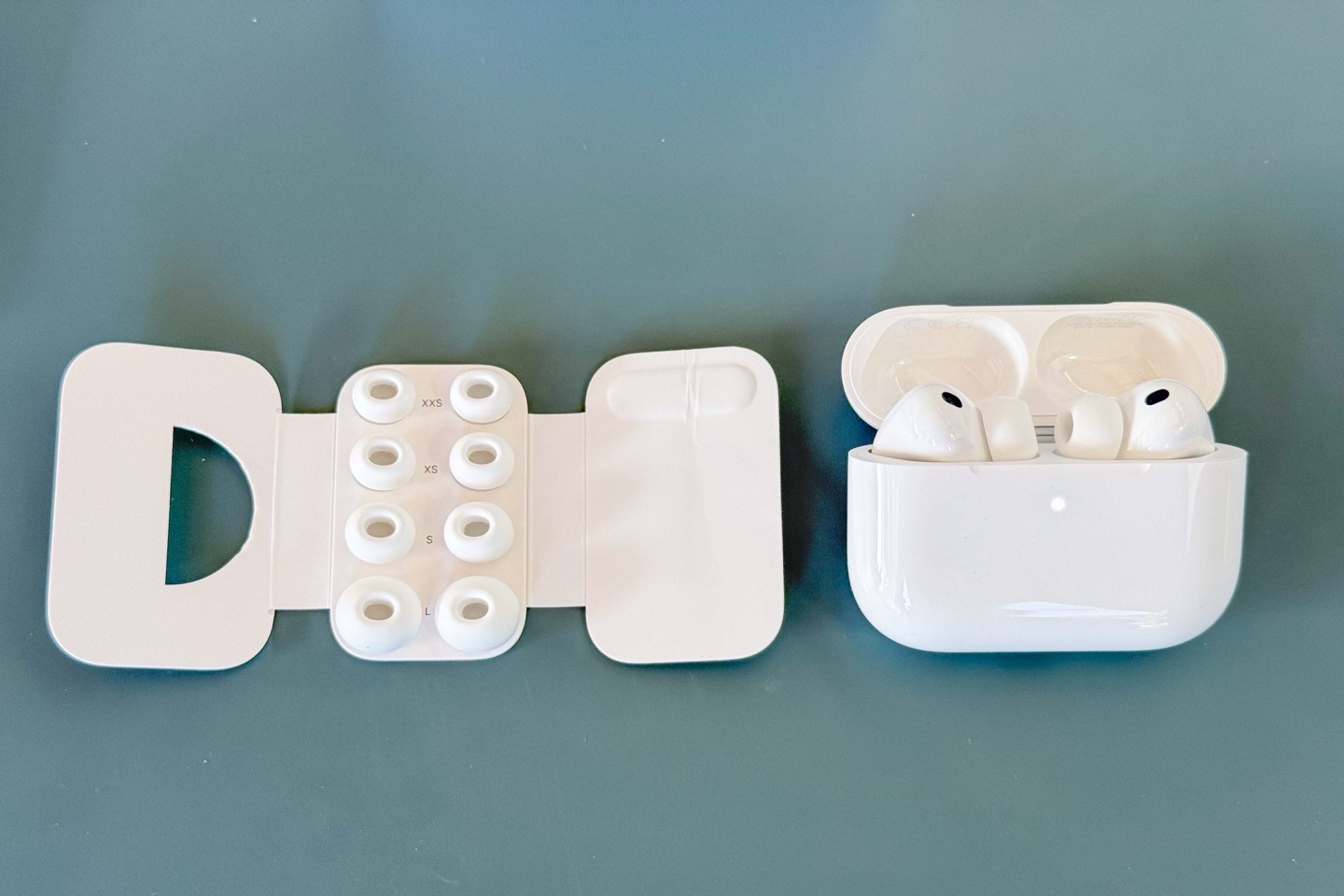
There is no USB-C charging cable included, which I’m fine with. If you’re a world citizen in 2025 buying the AirPods, I’m pretty sure you have a USB-C cable floating around. And if not, I’m sure your friends do. I would argue for higher-power devices (e.g., laptops and such) including them is still important given all the wonkiness on higher-power delivery devices. But for this sort of thing, it just doesn’t draw huge wattages, so just about any cable will do just fine.
The Basics:

Now, there are a million places to read about sound quality and such of the AirPods Pro 3, primarily from audiophiles. That’s not really me, and I suspect, not really you either. And, no offense to the Apple engineers, but most of us won’t be able to tell the difference between the already excellent sound quality of the previous generations and the new one – let alone do so mid-way through an interval while breathing hard with a bit of a cross wind.
Instead, I want to focus on the unit from a fitness perspective, but still quickly go over the basics. Because as much as I might use the AirPods in sport, I actually use them just *FAR* more for editing videos, listening to music on the plane, and random other boring tasks like conference calls.
First up, there’s the new fit aspects. They are definitely different. The first time you put them in, it’s like “wow, these fit totally different”. Then about 87 seconds later, you forget about it and it feels normal.
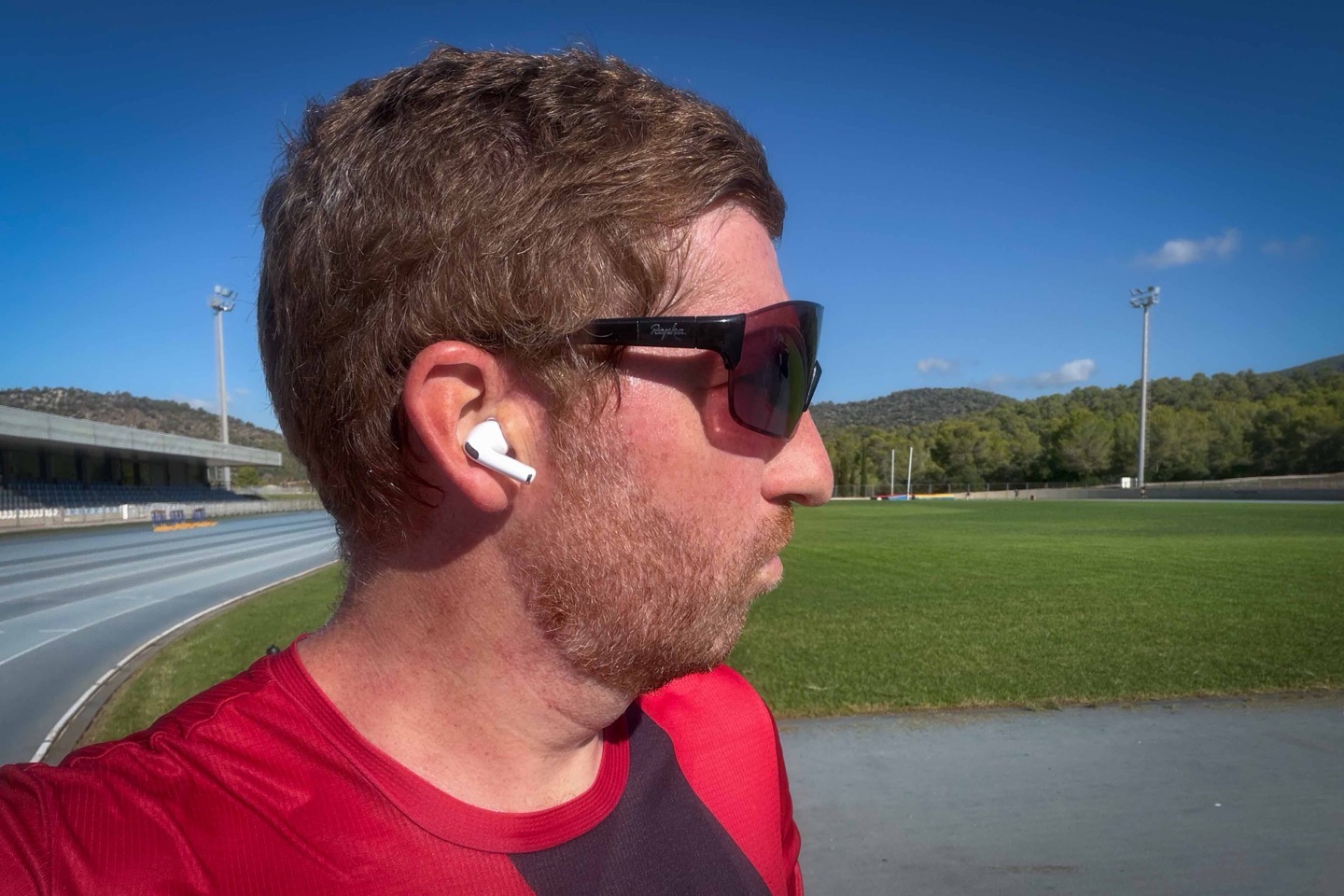
When it comes to the iPhone, after pairing it up, you’ve got a slate of options, though the most common one you’re going to use is the top one to switch between Transparency Mode, Adaptive Mode, and Noise Cancellation mode. In short, in transparency mode, you’ll hear all the conversations and noises around you. At the other end, Noise Cancellation mode makes the entire world go away. And then Adaptive Mode is effectively the middle ground. 99% of the time, I’m using Noise Cancellation mode, because I don’t want to hear anyone else. The exception to that would be in a city or such, where I do want to be aware of things around me.
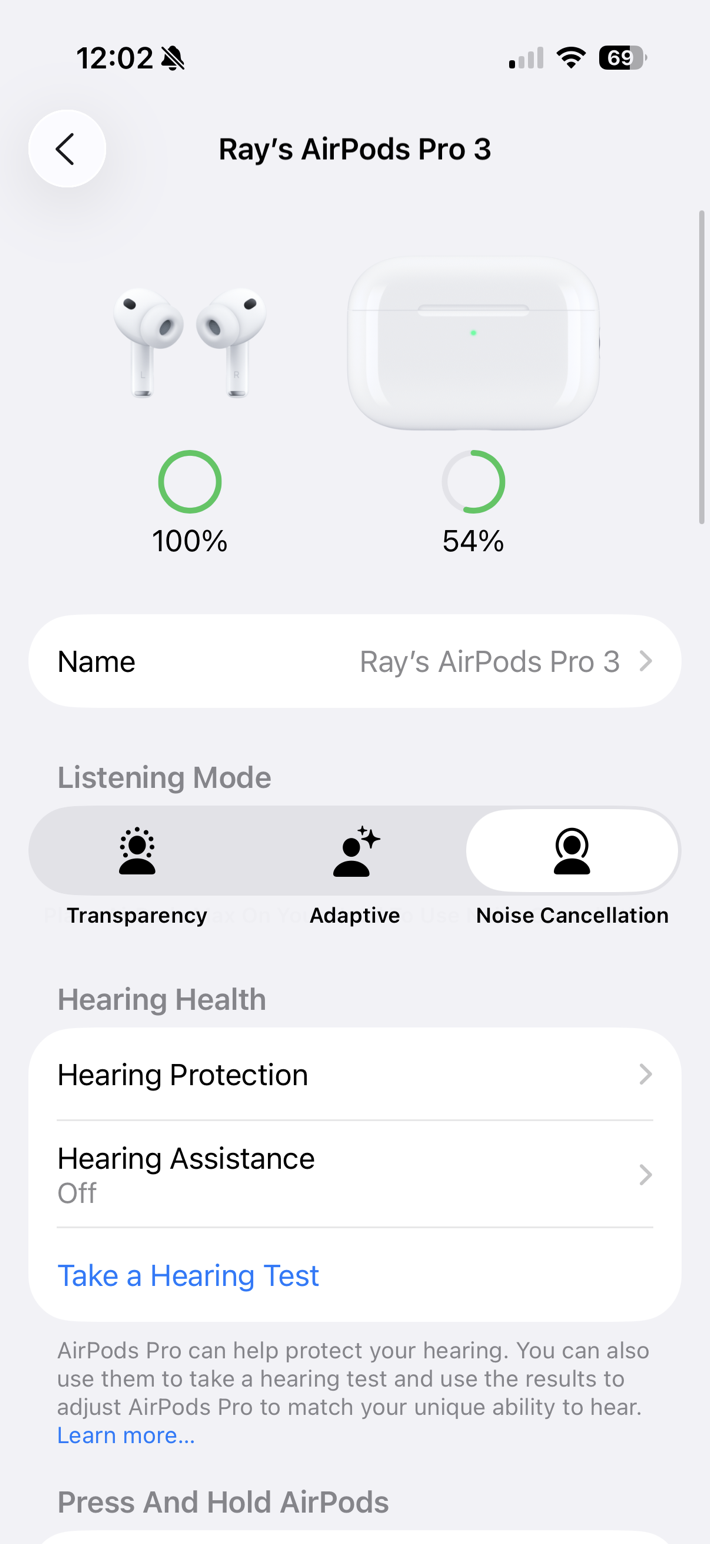
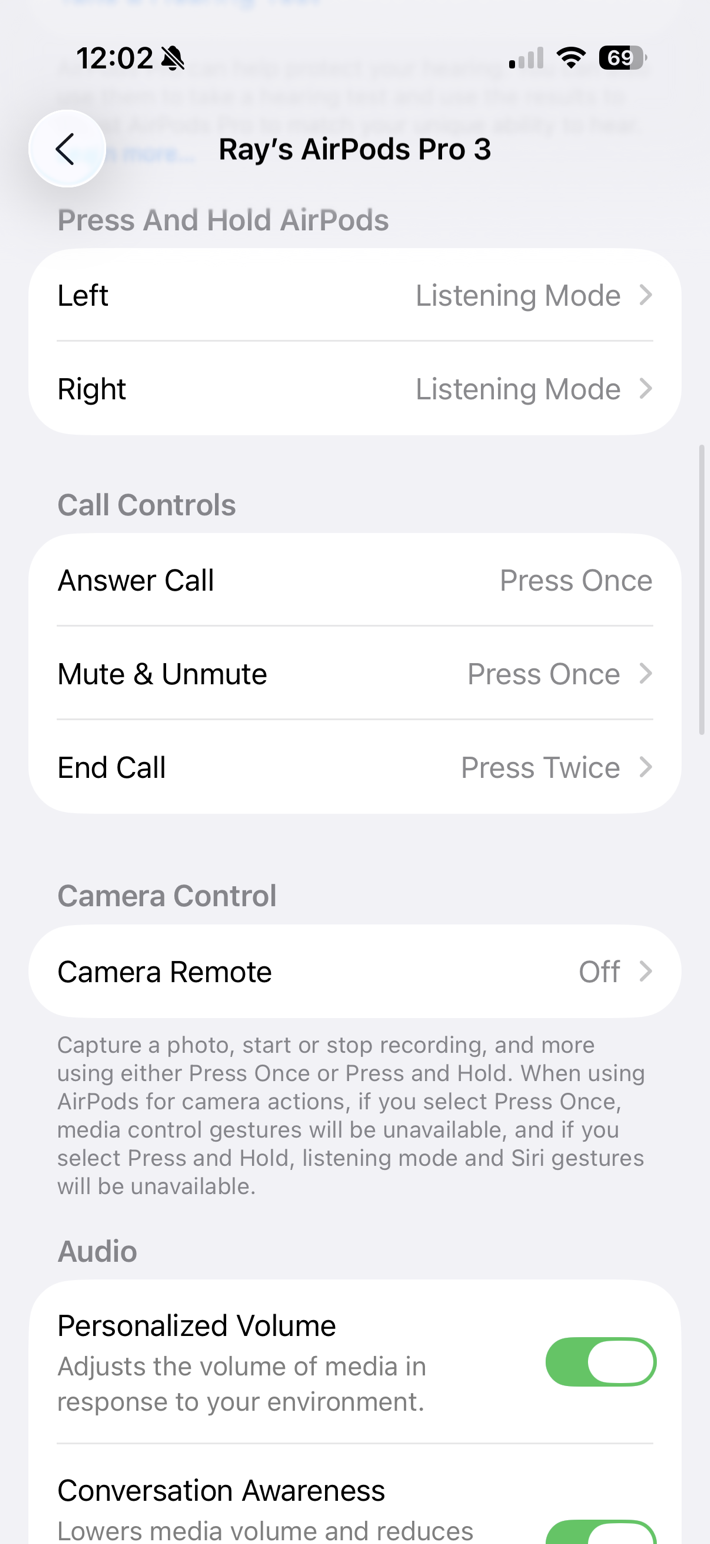
Next, you’ve just got a whole host of settings. Slightly more than 4 pages worth of settings you can tweak.
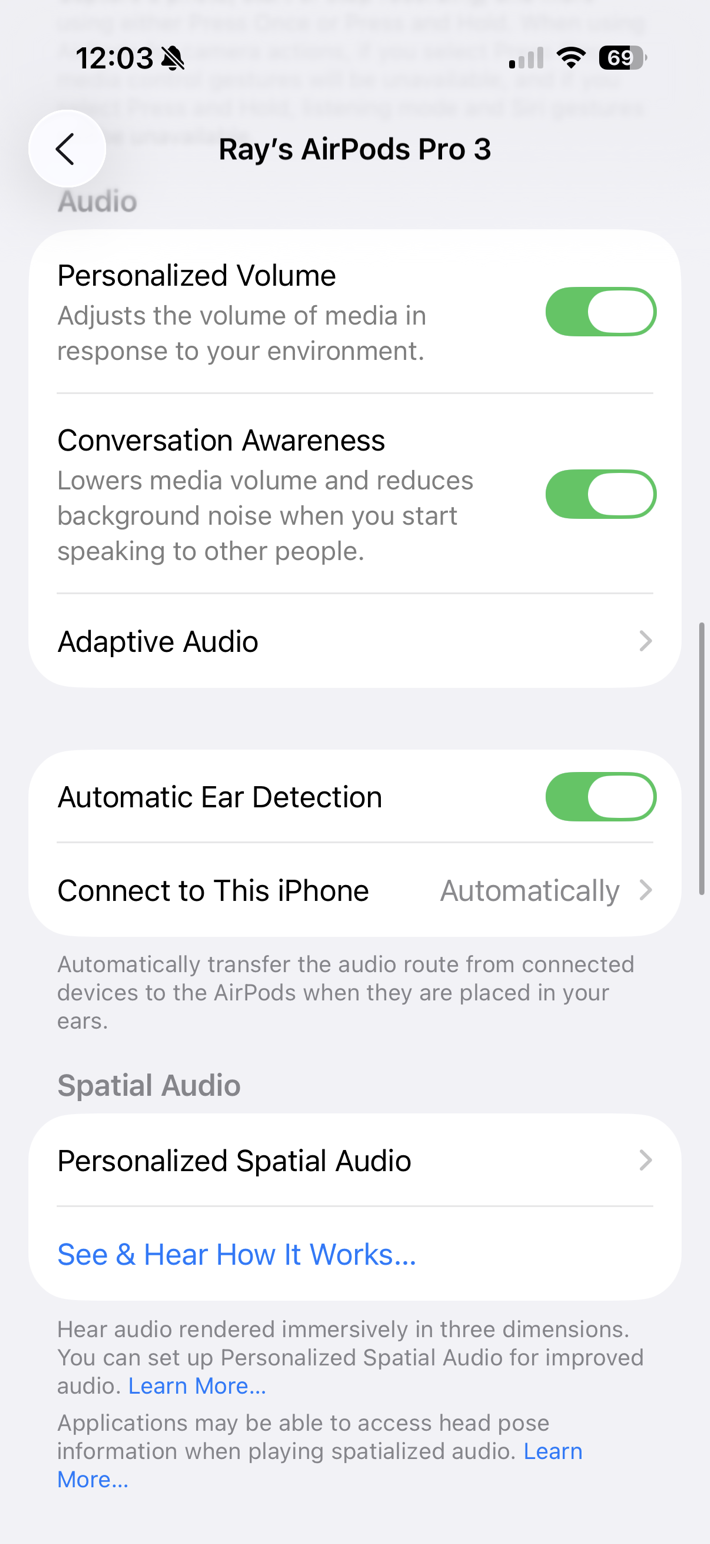
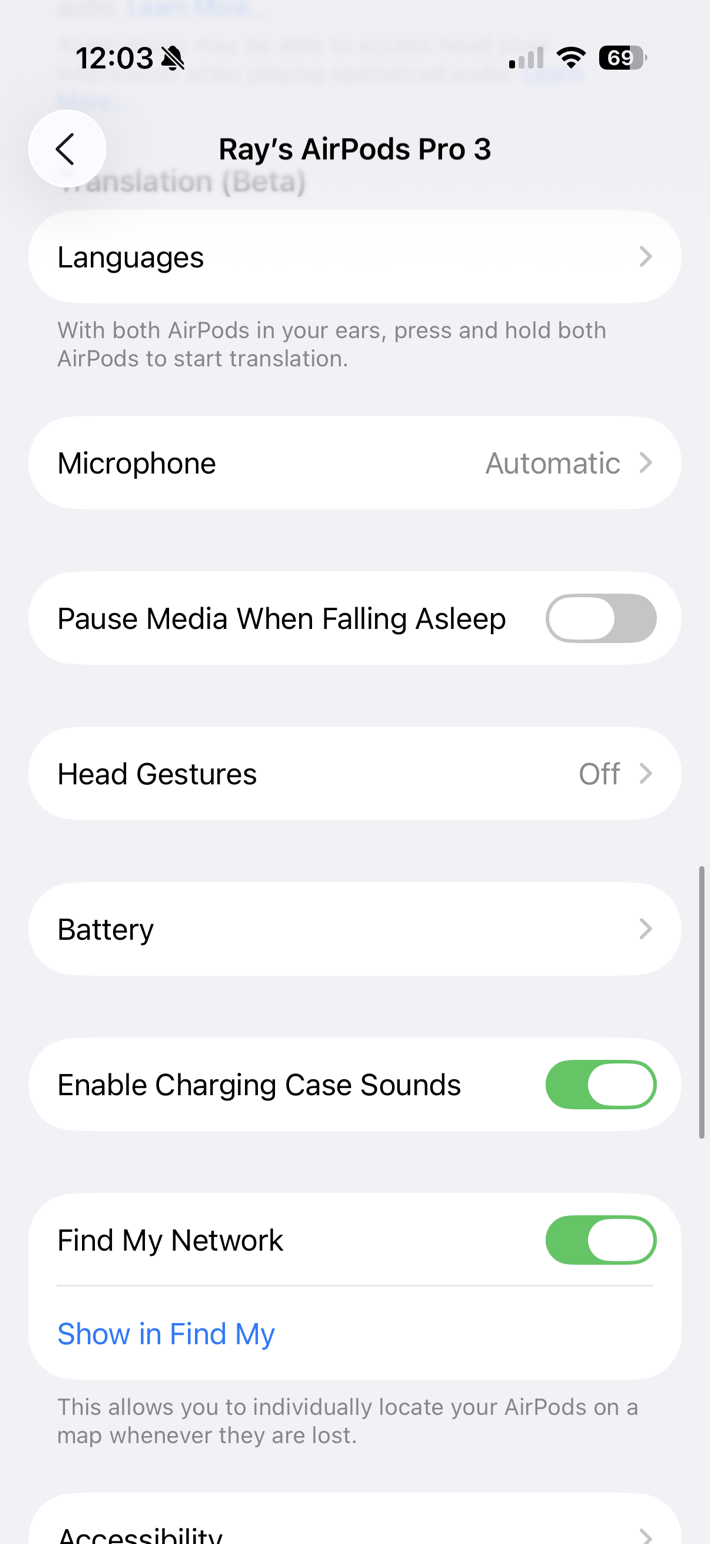
And of course, these are shown in your FindMy network, in case you lose your case (the case is shown, not each individual AirPod). You can also toggle off heart rate monitoring altogether here if you want.
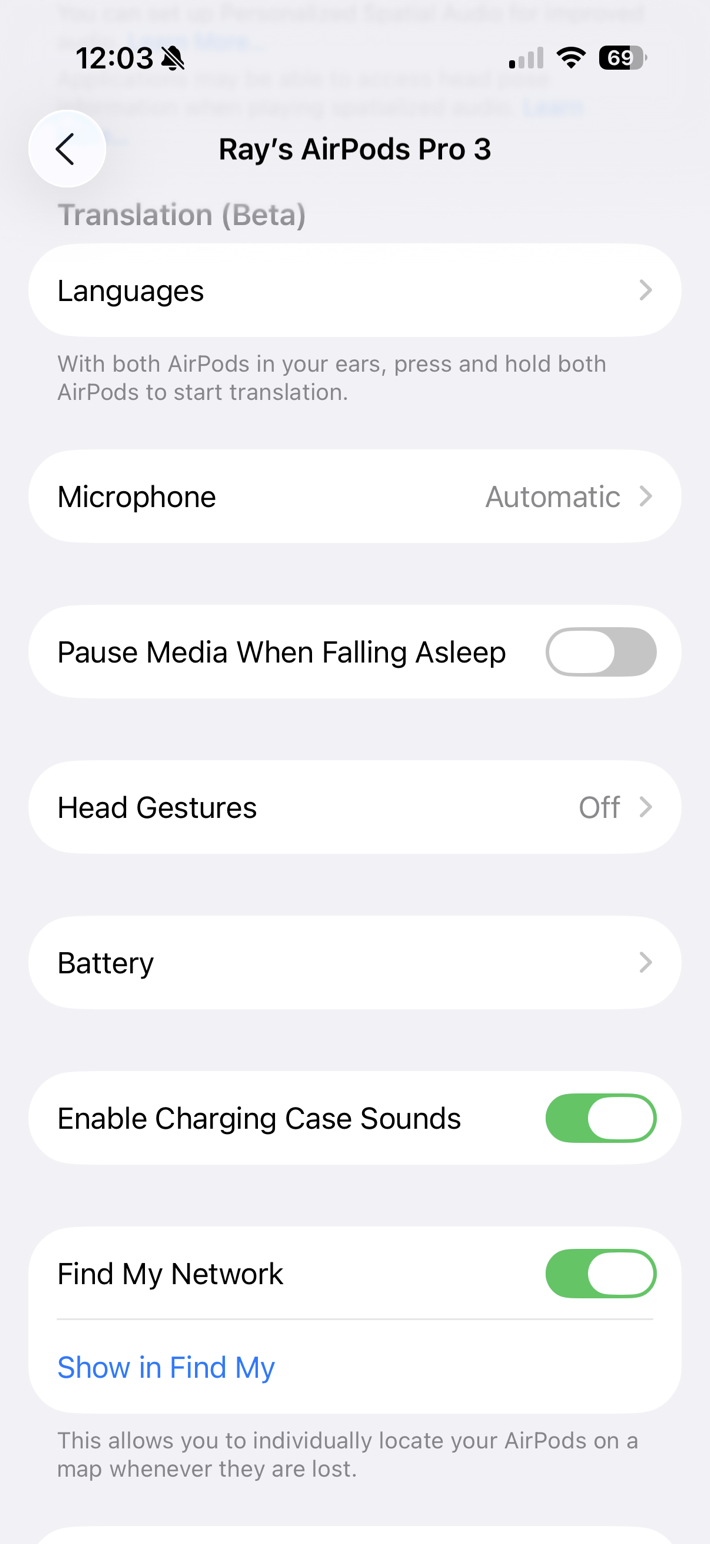
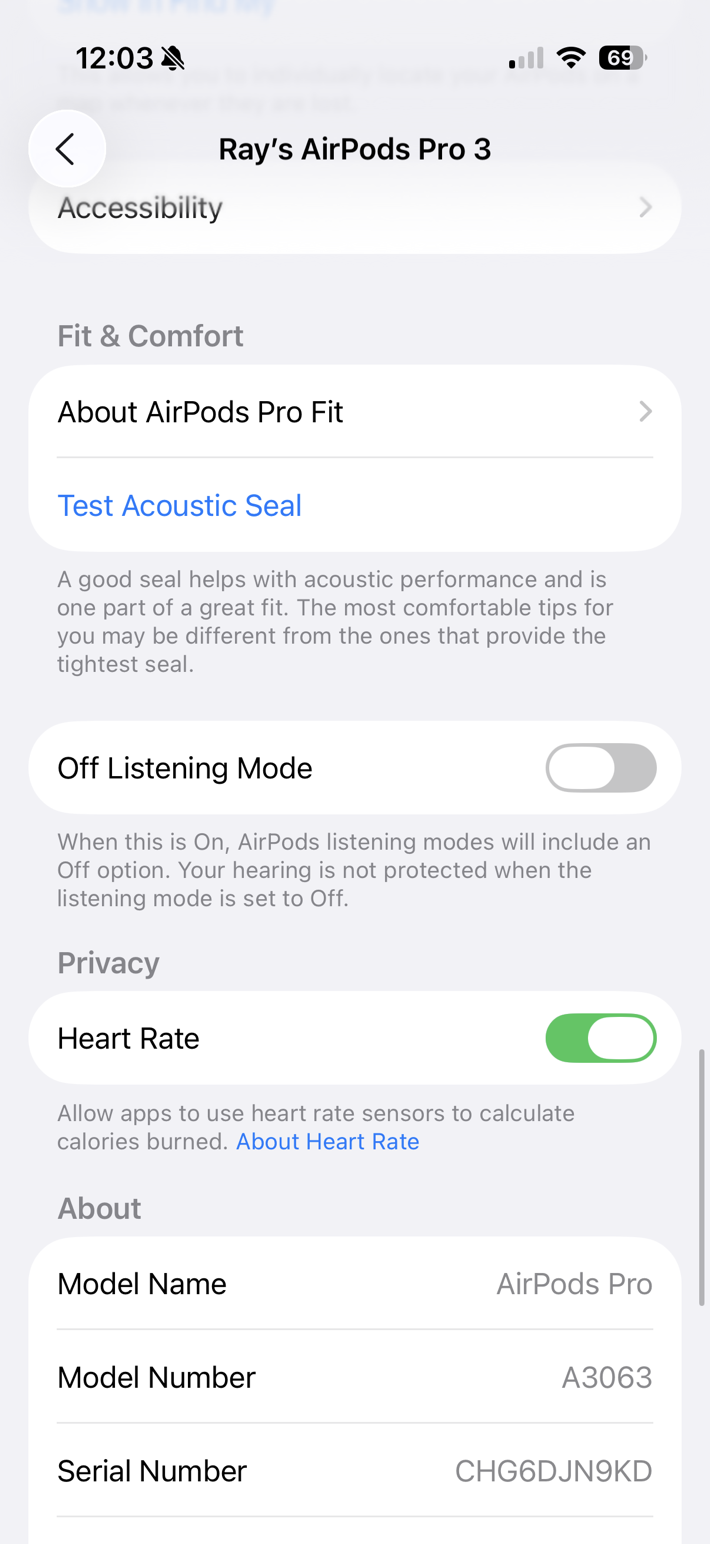
As noted earlier, there is the added eartip size, though I went with the default size, and it was perfect for my ears. Keeping in mind that while the HR sensor doesn’t measure through the eartip, the overall fit of the AirPods will drive accuracy. If it’s too loose/flopping around, then it won’t be accurate.
When it comes to that noise cancellation, it’s pretty good. I haven’t had a chance to test these on a plane yet, though. I did one better: A kids’ pool party. Specifically, more than half a dozen young girls, including my daughters, screaming all sorts of unintelligible things as they splashed around for hours. While it wasn’t perfect at silencing the craziness, it did give me just enough calm to get some editing done off to the side.
That said, noise cancellation during sport/wind is an entirely different scenario that I’ll dive into below.
Now, there is a new Live Translation piece here. This allows you to have a conversation with someone using another language where you’ll hear what they’re saying in near-real time. I say ‘near’, because it’s grouping their phrases together, rather than word-by-word. That’s logical, since the ordering of the words differs from language to language. You want the intended translation of the phrase, not the exact words in the order they were spoken. For the other person, you can show them your iPhone, and it’ll translate your words in realntime too.
You can download languages for offline (with your phone, but no connectivity) translation as well:
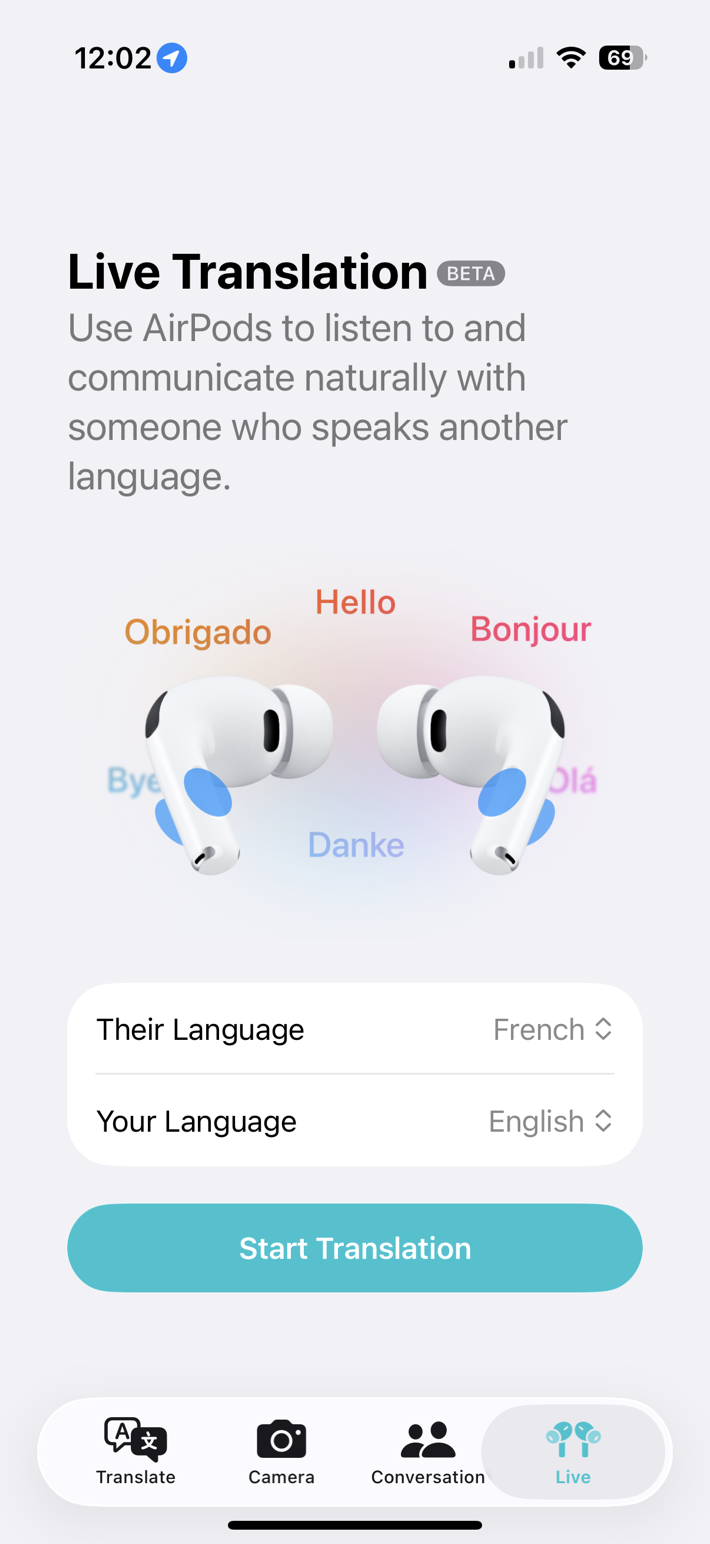

I haven’t had a chance to dig into this piece deeply. The demos I’ve seen first-hand were all at very slow spoken speeds, and very good there. And that’s great if you need to have a slow transaction in a foreign country in a shop or such (as Apple showed it). Or even a slow conversation for business purposes.
But on the flip side, it really struggles when it comes to translating faster scenarios. For example, when watching snippets of the Tour de France in French, using the Live Translation piece, for listening to the announcers, it didn’t stand a chance. It missed the vast majority of what was being spoken, and incorrectly translated the intent of other pieces. Note that it both shows the translation on the phone, and translates it audibly via the AirPods Pro 3.
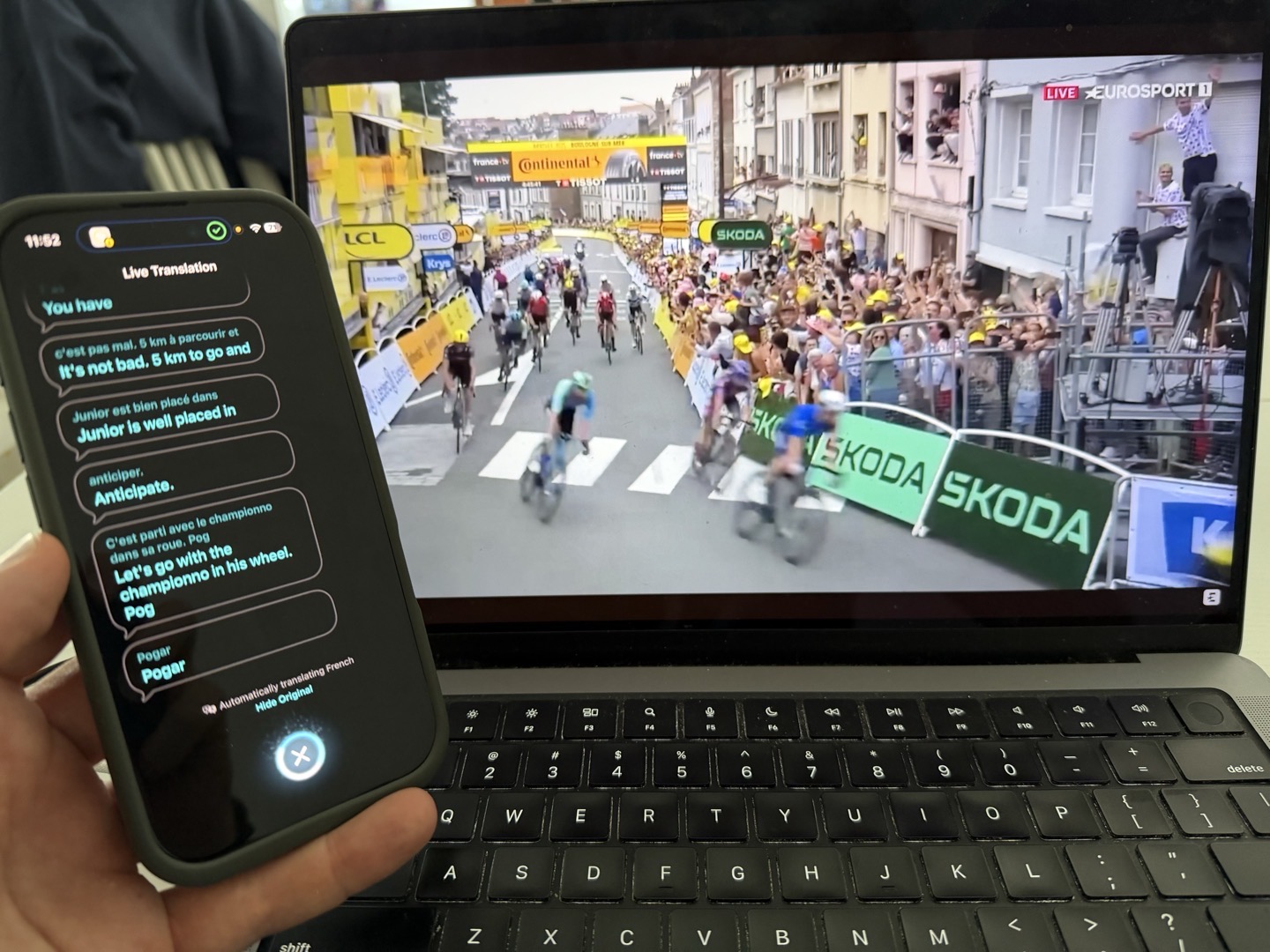
I often work at the Tour de France, and while my French is passable for many day-to-day pieces, being able to have translation on and listening to some of the announcements in the background and such would be helpful.
Don’t get me wrong, I think all the companies in this space doing this are doing super cool things. And obviously, you have to start somewhere. But just set your expectations accordingly.
Anyways, with that, let’s look at the sports piece.
Heart Rate & Usage in Sports:
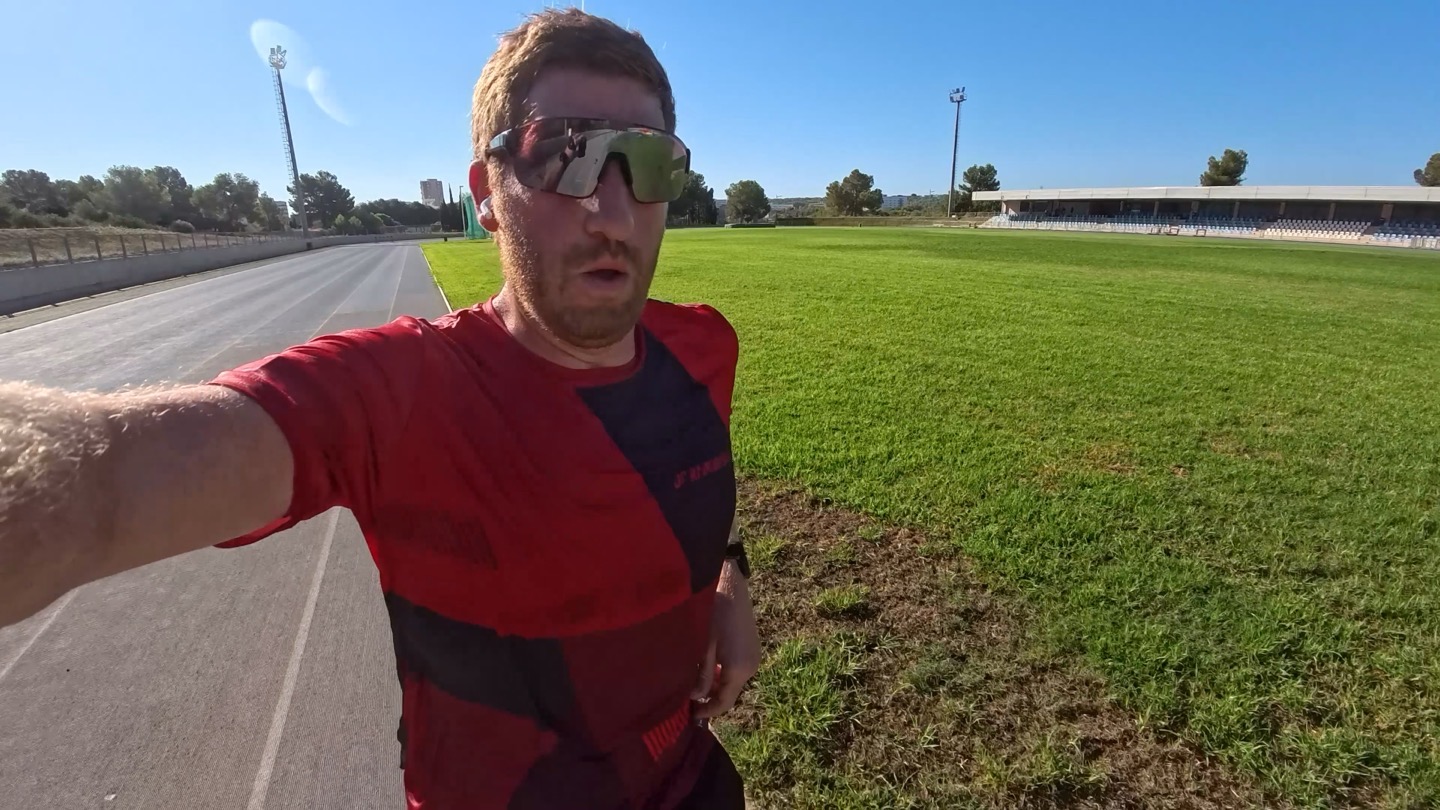
The biggest change in the Apple Fitness realm this September is, honestly, the inclusion of a full app feature dedicated to recording your data from your AirPods, and in fact, any heart rate sensor. This feature is found within the existing Fitness app, on a new tab called ‘Workout’. When you open up that tab, you’ve got a host of workout types (once you’ve paired an Apple fitness product, otherwise, it’s a more basic selection for just a general HR sensor).
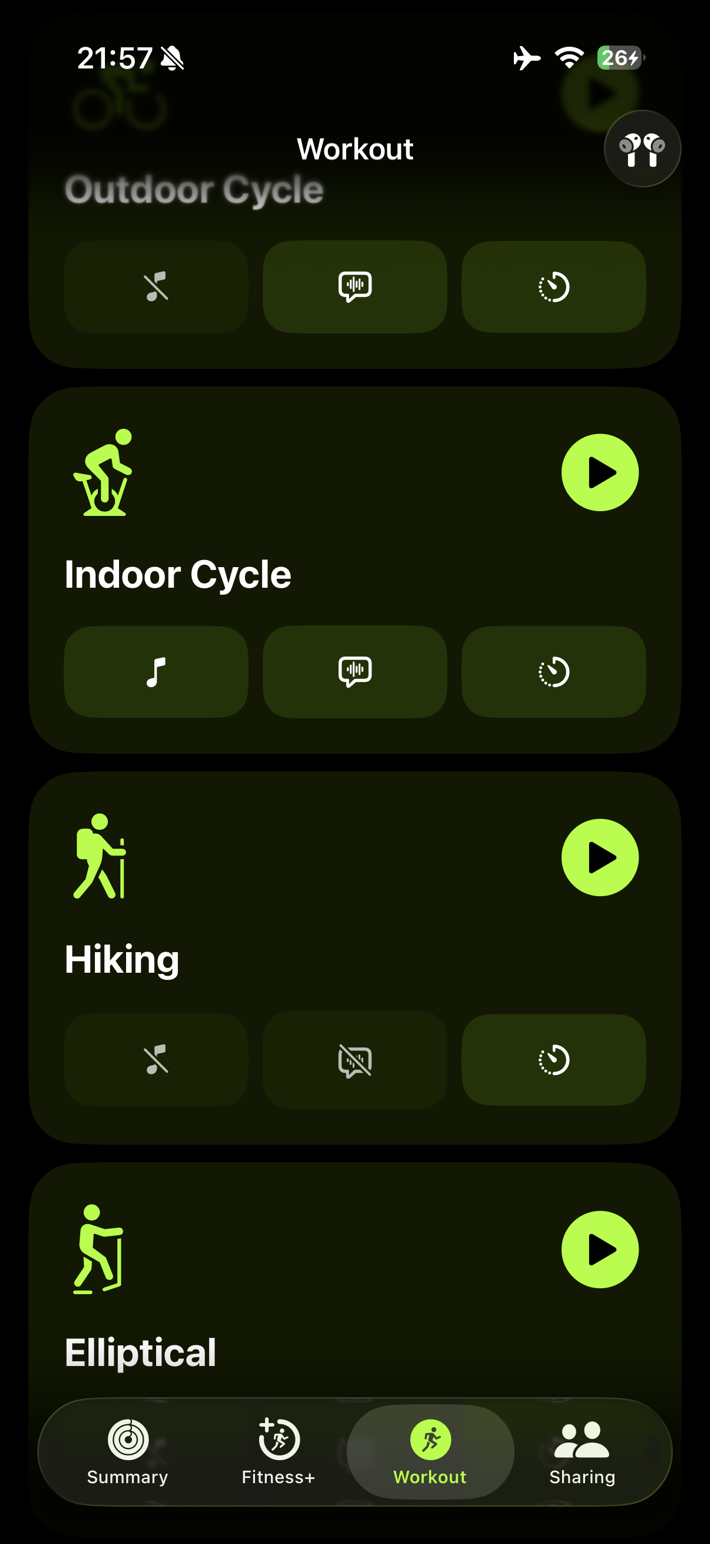
Below each workout type, there are essentially three options:
– Music
– Workout Buddy
– Goals (e.g., Calories/Distance/Time)
This isn’t super complex. But it does the trick. So, once you’ve got your AirPods in, it’ll grab the heart rate from those, and you can press the start button. From there, it’ll give you a 3-second countdown, and off you go. Workout Buddy will kick in automatically if enabled, and give you the Pep Talk at the start, followed by updates throughout the workout, and then finally, the Walk Off, at the end of the workout. This does require your phone to be with you, and that you have some sort of internet connectivity (cellular or WiFi). It’s the same as the Workout Buddy as I detailed/tested on the Apple Watch.
But first, it’s worthwhile mentioning *how* it does heart rate data recording. On the sides of the pods is a little black area, and under that are two infrared sensors that pulse light at 250 times per second. That’s notably different than the more standard green LEDs used in the PowerBeats 2 Pro (which didn’t work well):
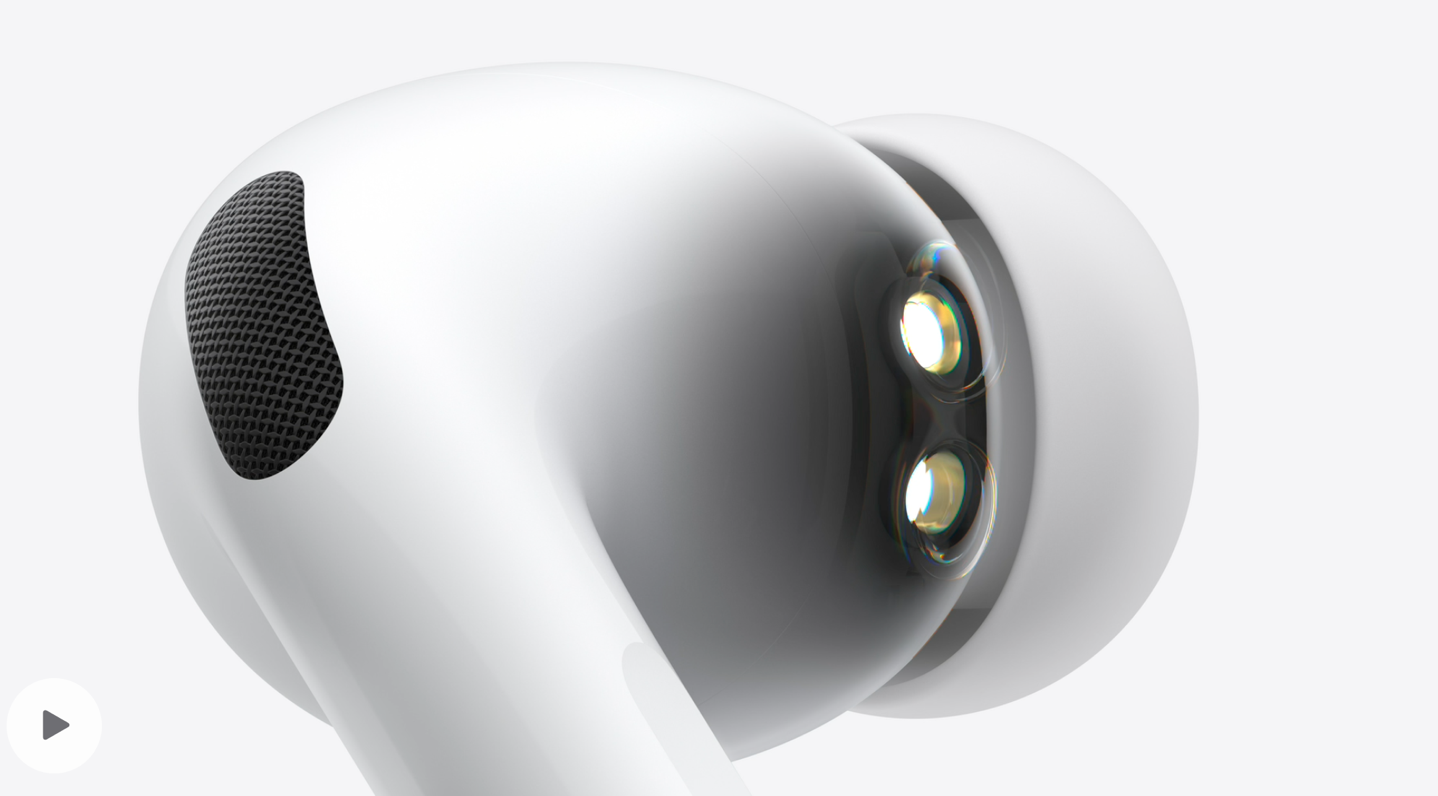
These infrared sensors look at the blood flow in your ears, and measure the movements of said blood. This data is then fed into a whole slate of algorithms, which attempt to figure out your heart rate, versus something like your thunking footsteps (which is typically what messes up HR sensors). In most cases, it’s the algorithms that are the magic for most companies. But we’ll come back to accuracy later on.
In any case, during the workout, you’ll see a single page of stats. Here’s an example from three different workouts (indoor bike, outdoor ride, and outdoor track run):
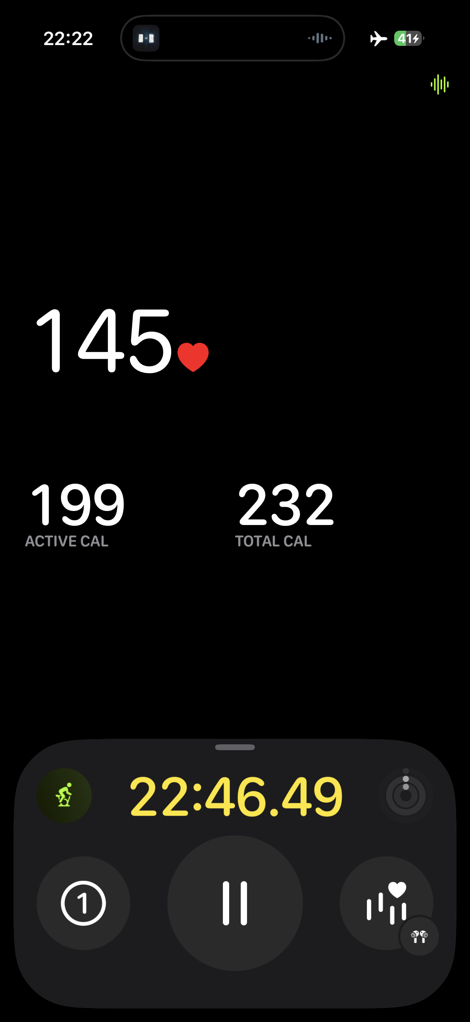


Again, there’s only *ONE* page of status, and these are not configurable. So, for example, I can’t see my current speed/pace, just the average speed/pace for the entire ride. I can see my current heart rate, and total calories, as well as total distance. And I can create laps. Otherwise, that’s kinda it.
Note that this will appear on the Lock Screen as a live activity. Further, if you swipe up while in the Fitness app, you’ve got a few more options, including muting Workout Buddy, and doing a Check-In.
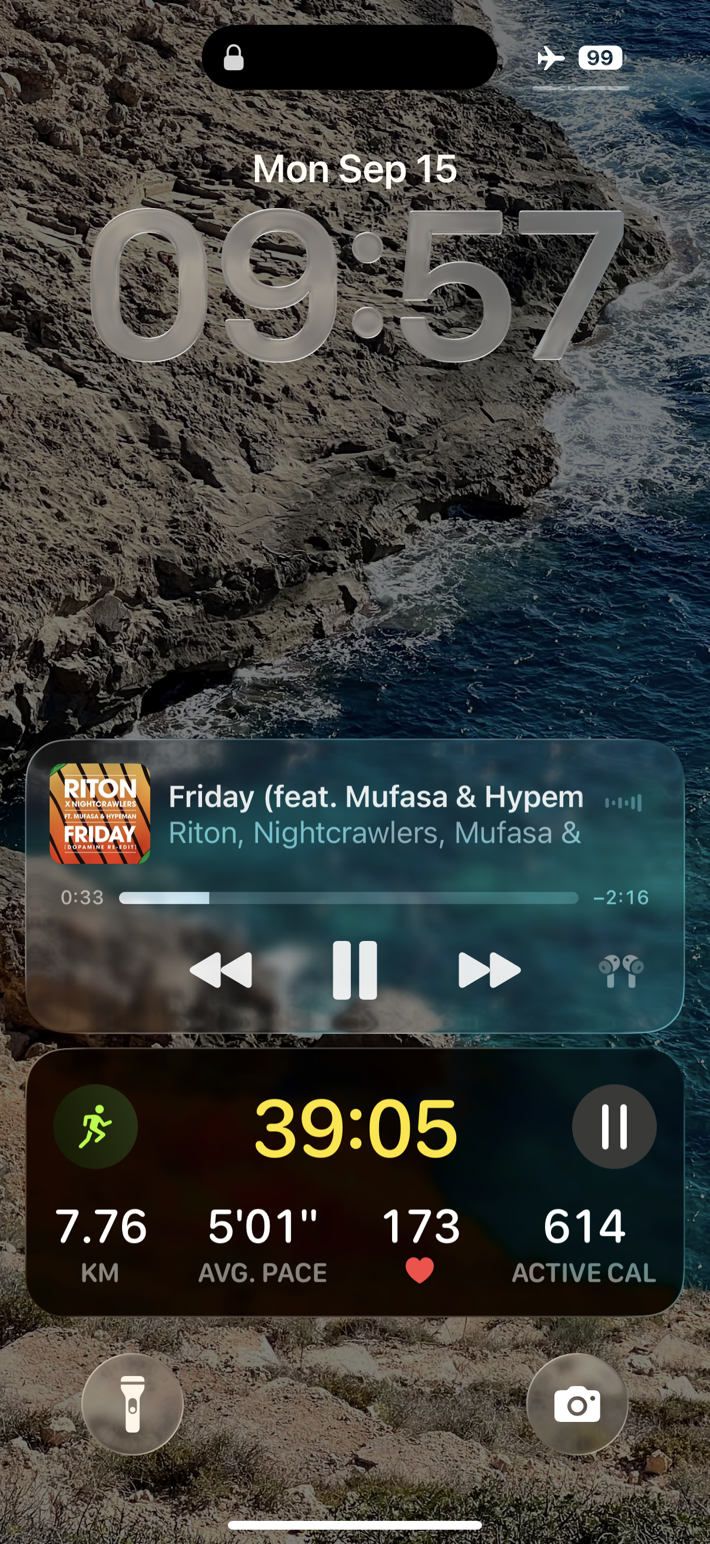
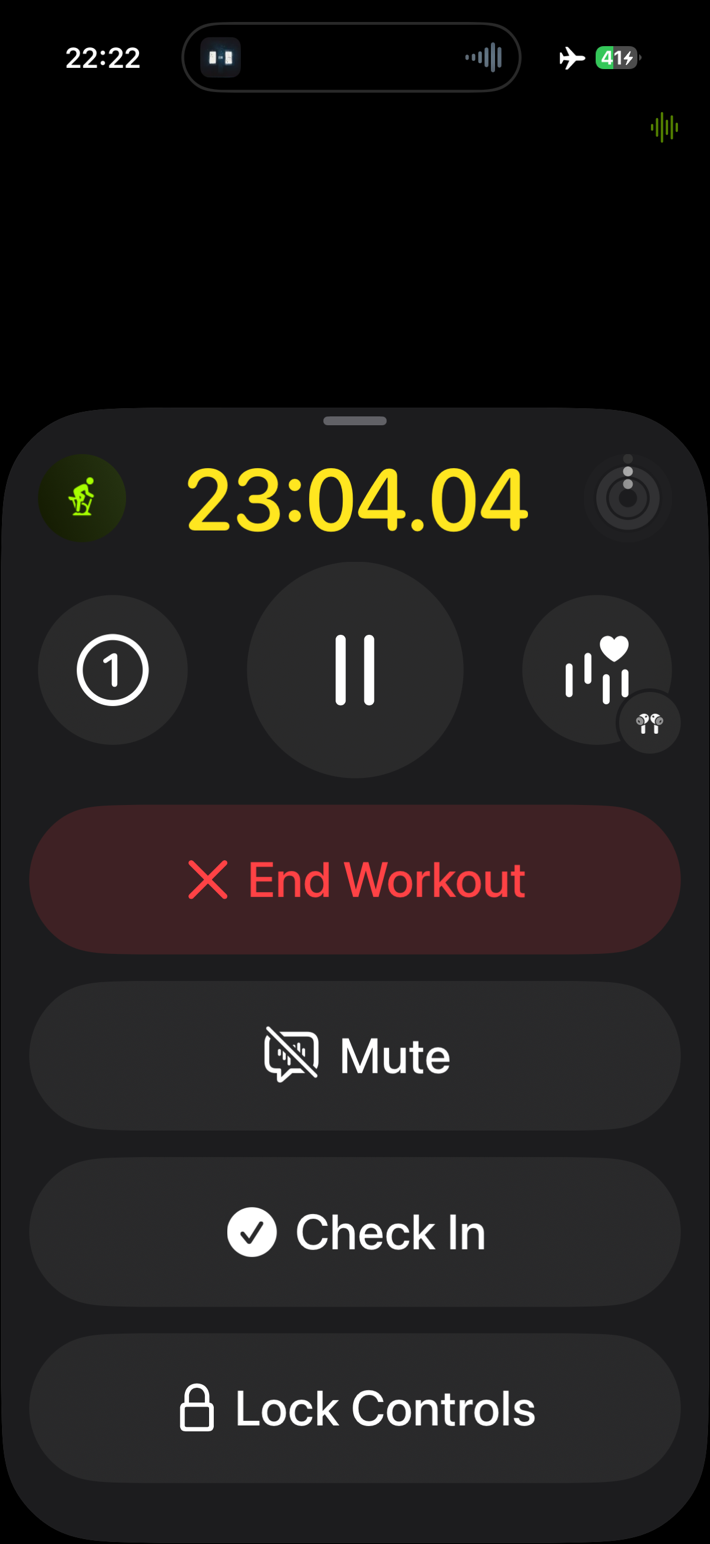
Once you’re done, you can hit pause, and end things. This will bring up a selection of summary stats:
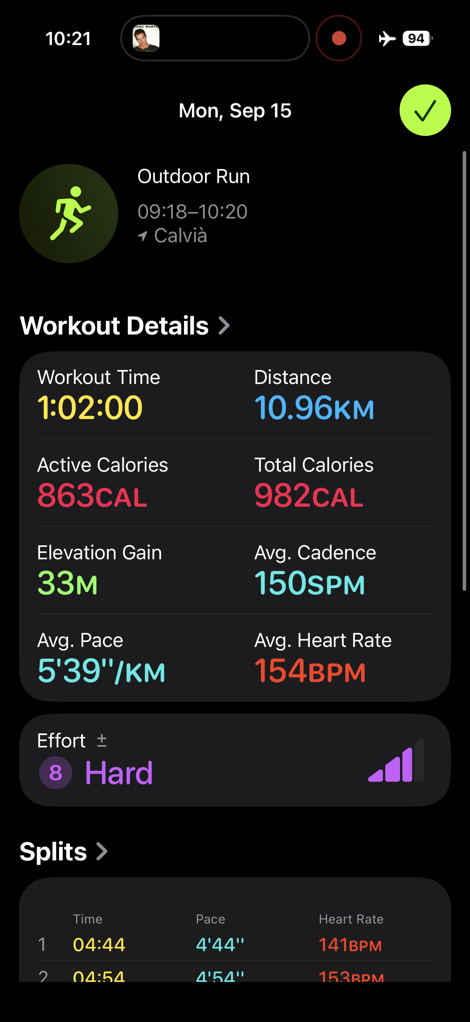
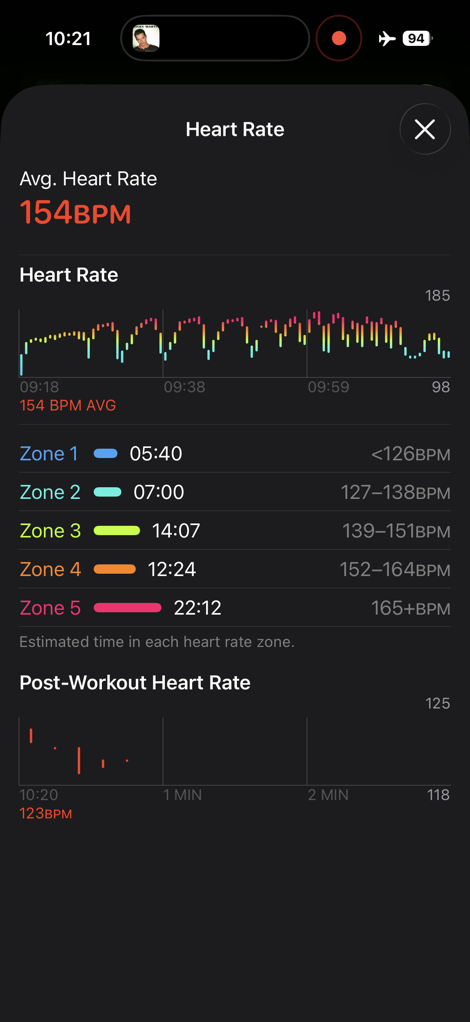
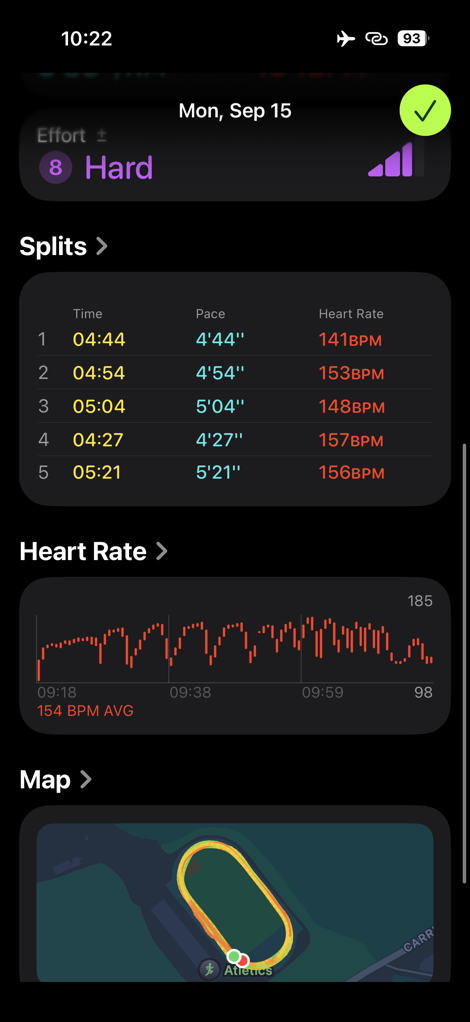
One of the options you’ll have here is to Rate Your Effort, which will in turn update your training load data.

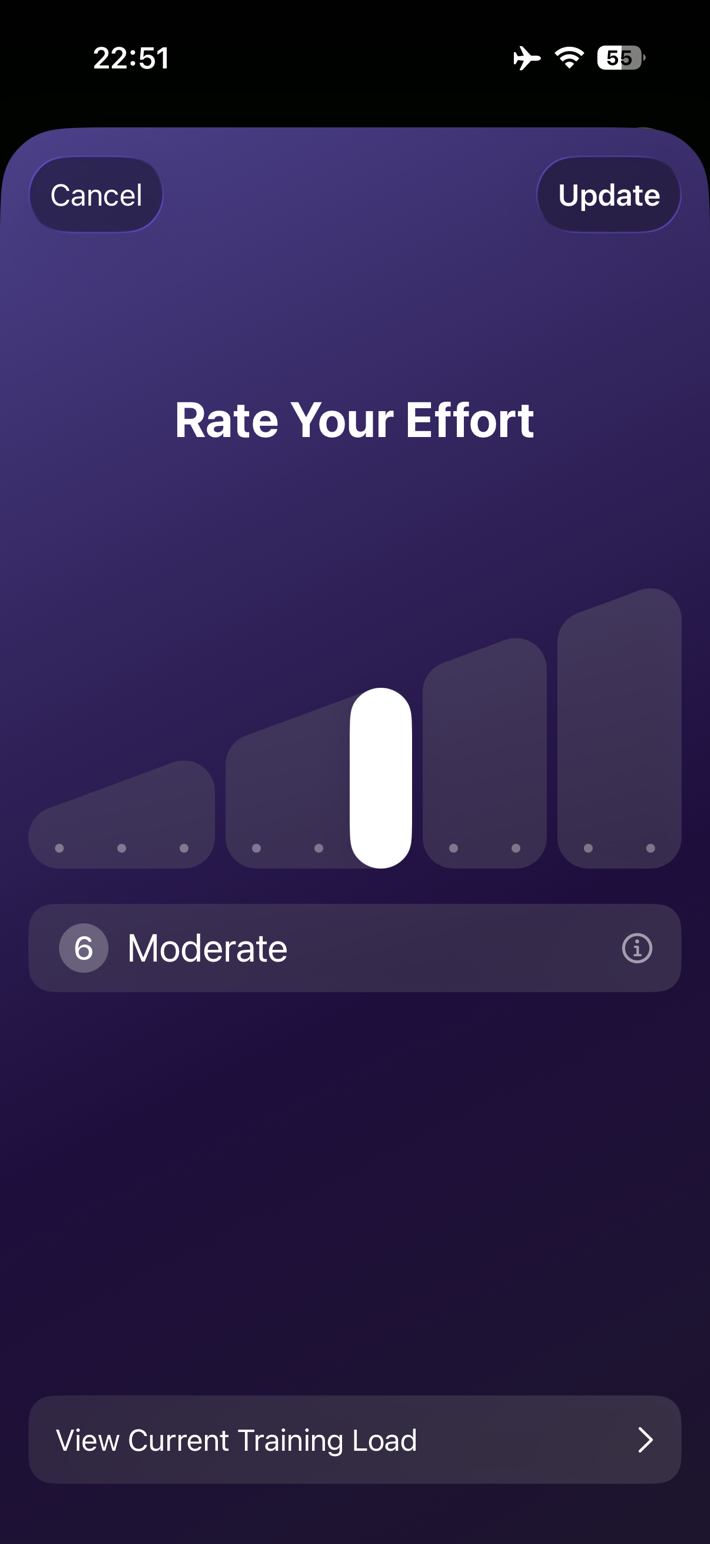
You can then view/plot this data longer-term if you want to:
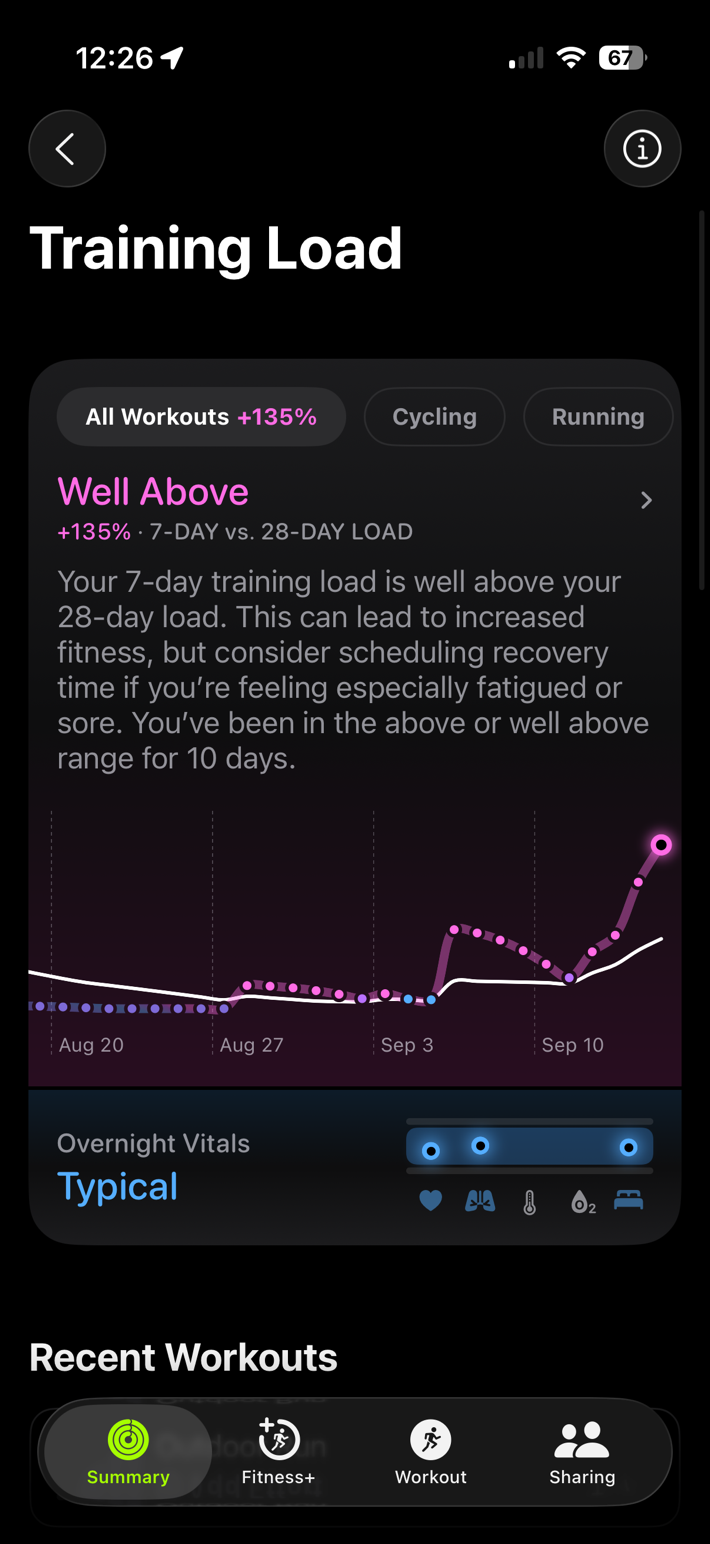

Next, let’s talk briefly about noise cancellation during workouts at speed/wind. I should note that I generally don’t recommend riding outside with in-ear headphones (bone induction headphones would be different). It’s usually a safety risk since you can’t hear traffic overtaking you (or anything else for that matter).
In any case, Apple said they changed aspects of the wind flow within the headphones, which may or may not improve how much wind you hear. You see, one of the challenges with either transparency mode or noise cancellation mode is that it’s actually using the microphones on the outside of the AirPods to pull that audio inside to you. But it has to figure out what’s wind and not, and then remove that wind noise.
While there are some improvements here compared to the AirPods 2 Pro, I don’t feel they are vast improvements. It’ll still sound like a tornado is in your head, though the audio is usually listenable for all but the fastest descents.

That said, in either scenario, there’s absolutely ZERO awareness of cars overtaking you. On this particular ride my cycling radar wasn’t with me (long story, a rarity, it just wasn’t), which usually would alert me to overtaking traffic. However, it was astonishing how even on a relatively quiet country road, how quickly cars snuck up on me (in either transparency or noise cancellation mode). Never heard them. So again, totally cool for indoor usage, but definitely not for riding outdoors.
Now, it’s worthwhile pointing out you can use these in a single-ear configuration. So you can place one AirPod in (either one), and it’ll still transmit your heart rate (HR) data. Further, in this configuration, your other ear could then listen for traffic.
For running, it was good, though still a bit of wind noise when the wind blew in certain directions.
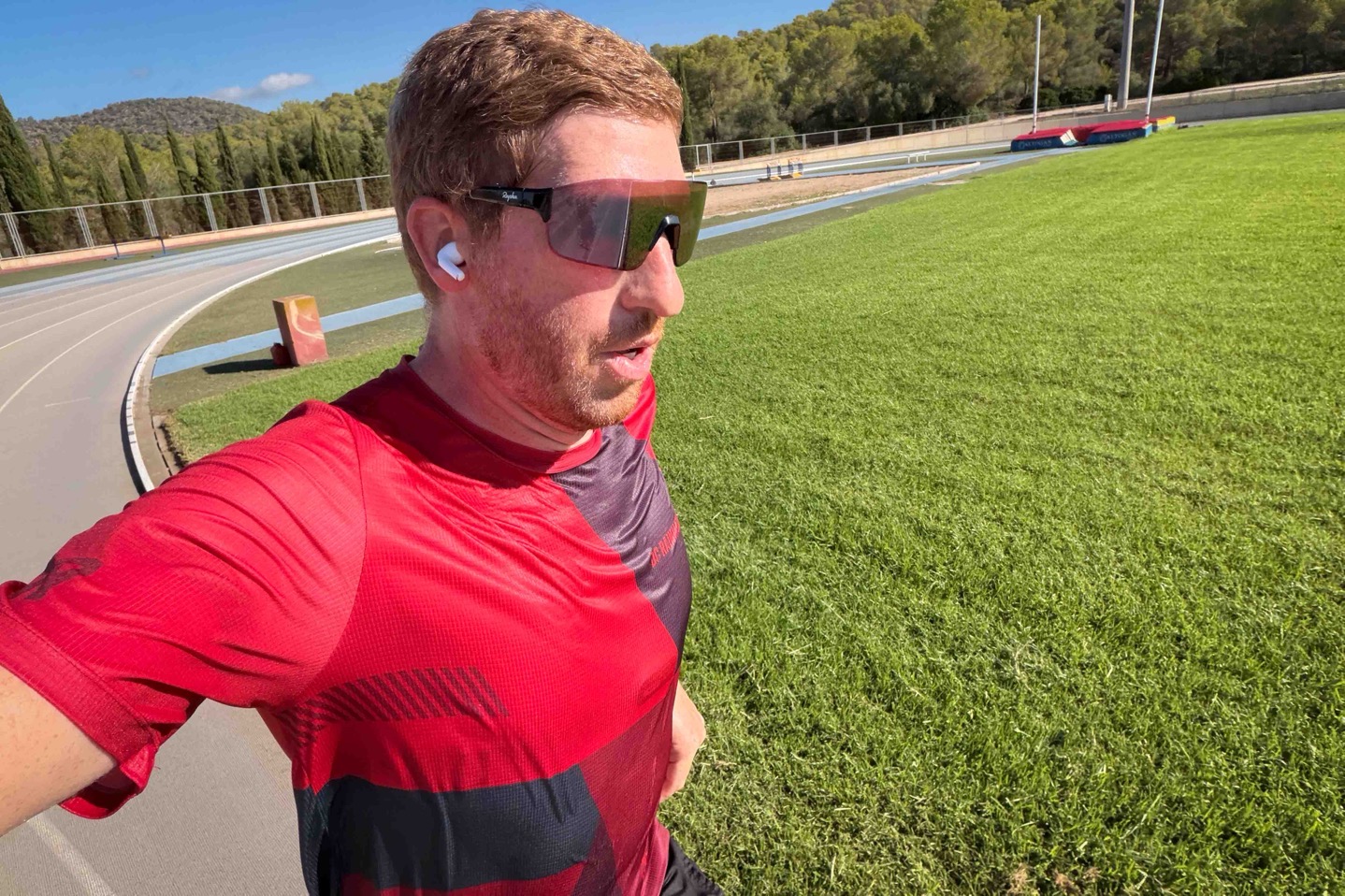
Ok, let’s talk about waterproofing briefly. The AirPods Pro 3 actually have increased waterproofing from IP54 to IP57:

The first number (’5’) in the IP number is talking about dust resistance, whereas the second number is covering water resistance. And in this case, it increased to ‘7’, which technically means it supports 30 minutes at 1-meter deep. Yet also technically, Apple’s site says not to immerse them:
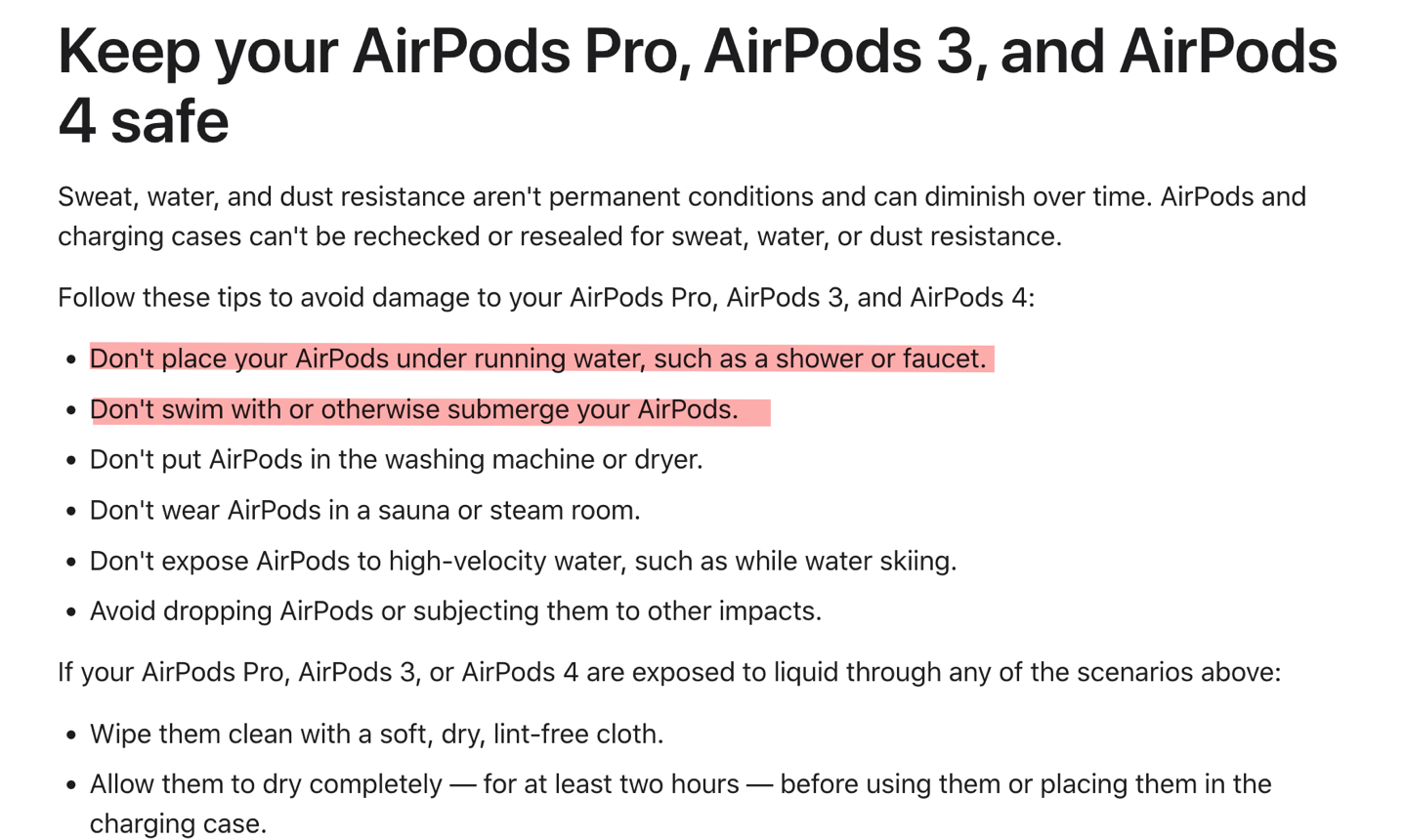
Obviously, since Apple touted meeting that standard, I’m going to validate it. So, off we go.

Now, a couple of things of note here. There’s no music/sound coming through. This is because once it loses connection with my phone (which was actually with me in the orange openwater swim bag near me), it drops the signal. It did this instantly upon hitting the water. Also, the water may just be causing it to pause the music too. Either way, it doesn’t work (which is different than other headphones designed for swimming that do have offline playback modes).
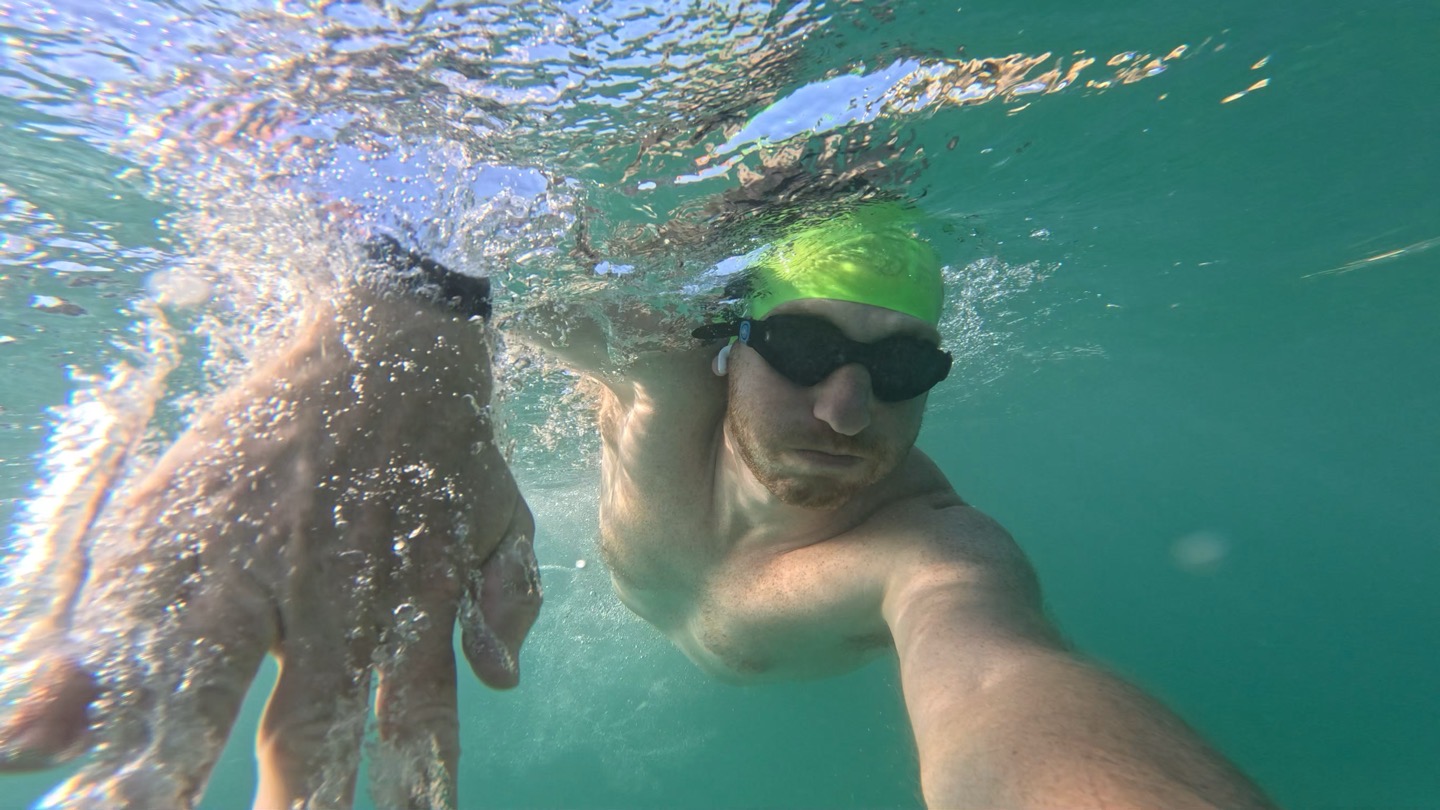
The second thing to note is just how good the fit was. My wife looked at me and was like, ‘You are definitely gonna lose these’, but there was no chance I was losing them (this has not been a strong summer for me and losing things on my openwater swims). In any case, they were locked in there, both above water and a bit deeper.

Afterwards, per the usual caution about putting devices in saltwater, I rinsed them off with fresh water. See, safety first! Err…last.

I let them dry a bit, and they were good to go. No issues since then, and all is good. Which makes sense, because again, on paper, that’s literally what it says they support.
Now, a key difference between the AirPods Pro 3 headphones and the PowerBeats Pro 2 when it comes to the heart rate signal is that the AirPods Pro 3 are *NOT* sending out a standard Bluetooth heart rate signal (BT HR profile signal). Whereas the PowerBeats Pro 2 actually do send out a standard Bluetooth HR signal that’s compatible with virtually every app & 3rd party device made over the last decade or so. This is important for areas like a Peloton Bike, which can pair with the heart rate of the PowerBeats Pro 2, but not the AirPods Pro 3. Likewise, if you have other devices like dedicated bike computers, or simply just an Android phone – you won’t be able to get the heart rate signal on those devices.
It sounds like Apple views the PowerBeats Pro 2 as part of the greater Beats brand, which is designed to be slightly more device-agnostic (hence still drawing in Android users). And sure, that’s fine. But the reality here is that this is limiting their appeal to actual iPhone owning users, too. The majority of Peloton owners are on iPhone. The majority of Garmin bike computer users are on iPhone. The market for these higher-end devices skews overwhelmingly iPhone (as it has for more than a decade), and this ignores their best customers.
And that sets aside the Android realm. No Android user is going to switch phones just for the AirPods Pro 3. But, they might just go and buy them if they fit their fitness use cases. Now, if they need heart rate, they certainly won’t. Again, this whole decision is baffling.
Ok, with that, let’s get into the accuracy bits.
Heart Rate Accuracy:
For all of the heart rate accuracy recording here, I had separate devices/phones recording the data. Thus, when an Apple Watch was also involved, it was on an entirely separate phone/account (and therefore, might as well be a friend’s phone). All other watches/devices recorded separately to themselves, and the AirPods Pro 3 recorded directly into the Apple Fitness app on an iPhone updated with iOS26.
First up, we’ll start with something that should be relatively easy – indoor cycling. I say ‘easy’, because while my heart rate will fluctuate quite a bit, my head isn’t really moving anywhere in the grand scheme of things. It doesn’t have to figure out the difference between heavy footsteps running down a hill and my heart rate, there’s not much signal noise, etc… In the grand scheme of heart rate monitoring (of all sensor types), indoor cycling is pretty much the easiest to do:
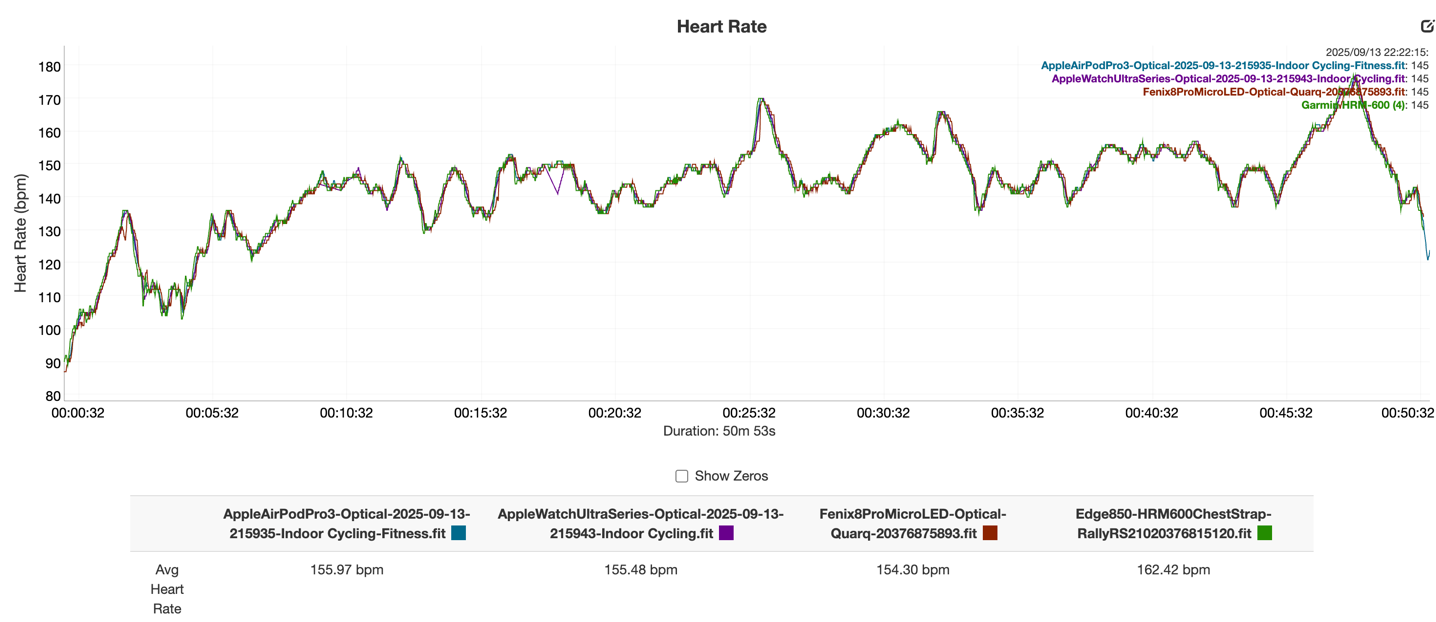
And indeed, it nails this. Kudos. Then again, so did the PowerBeats 2 Pro. Again, this is the easiest possible bar to test.
So next we’ll increase the bar with a steady-state run. Nothing complicated here, just…well…running at an even steady pace outdoors. Here we can see the results:
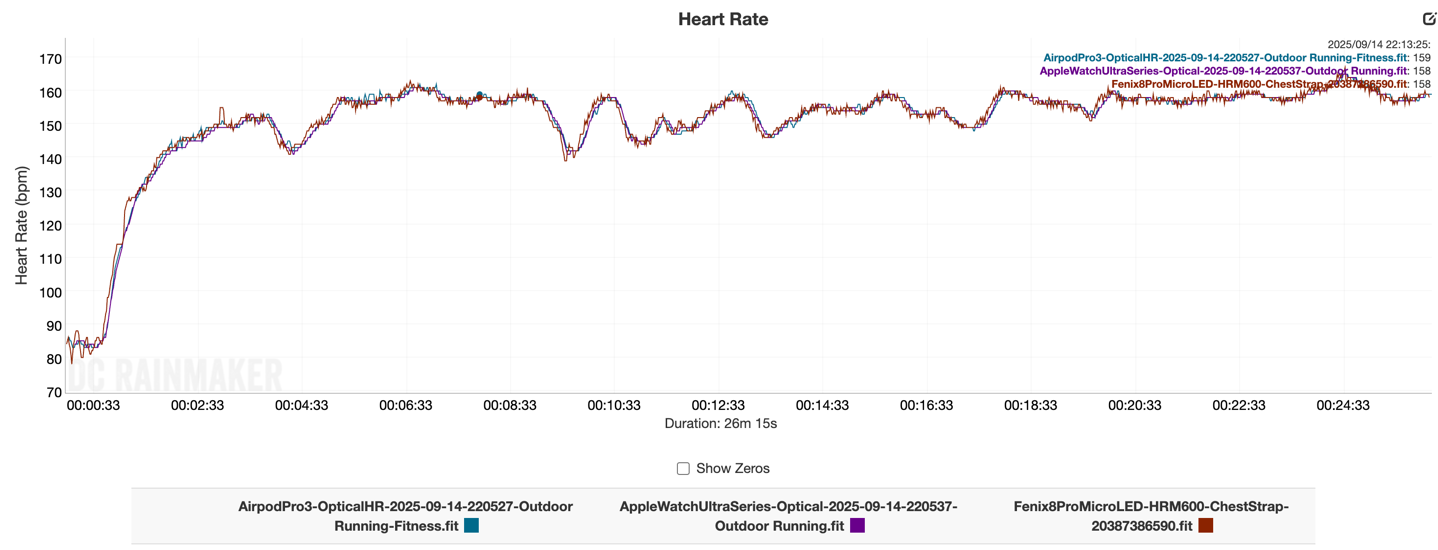
As you can see, that’s really good, and virtually indistinguishable from the other units. This isn’t considered a complex task, but hey, the PowerBeats 2 Pro would have failed this one too.
Next, we’ll increase complexity with an outdoor ride. This is one of the areas that can be very tricky for optical sensors, primarily wrist-based ones. Your wrists are flexed stiff, and often absorbing the vibrations of the road. Thus when a watch gets this correct, it’s pretty impressive. For upper arm band-type devices, they tend to do super well here, because the rest of the arm acts as a shock absorber. And therefore, when you look at ear-area devices for optical HR sensing, you’ve got your entire body acting as a shock absorber. In any case, here’s that data:
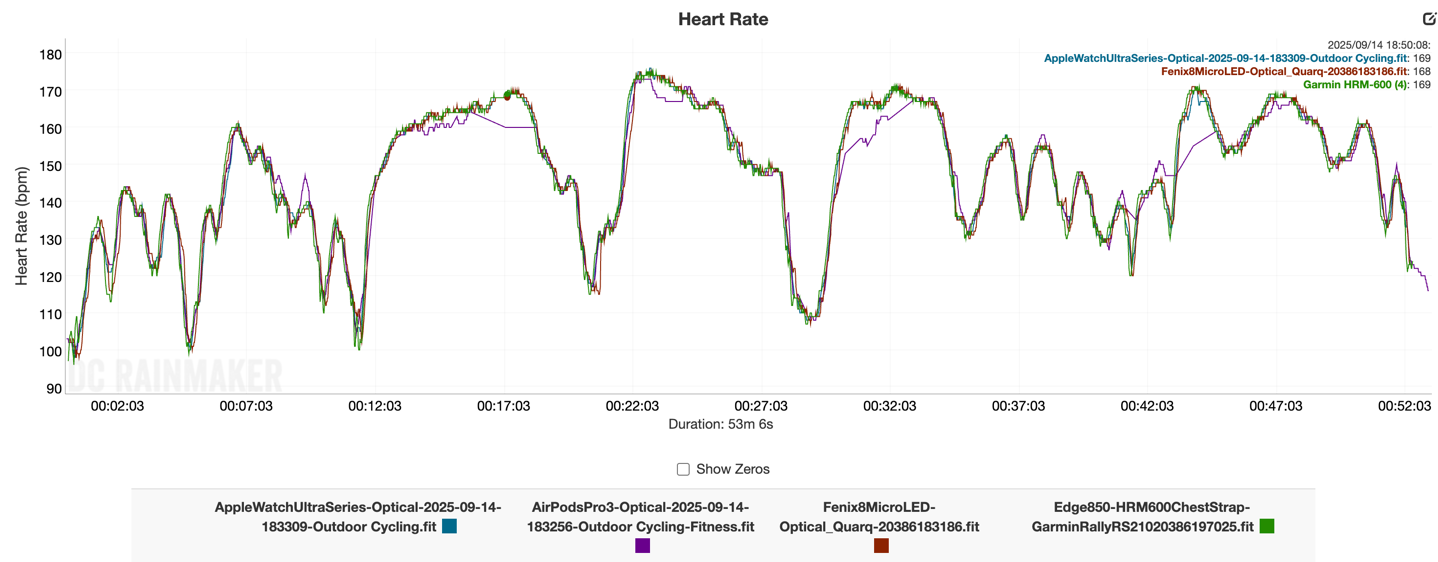
Overall, this is pretty darn good. You do see a few moments (in purple) at the peak of an interval when it struggles a bit. Interestingly, usually you see the struggling happen on the ramp up into the interval, but this was at the steady-state portion, which is kinda a quirky failure.
Finally, we’ve got an interval workout set. This was 4×800, then 4×400, then 4x30s, plus some warm-up and cool-down boringness:
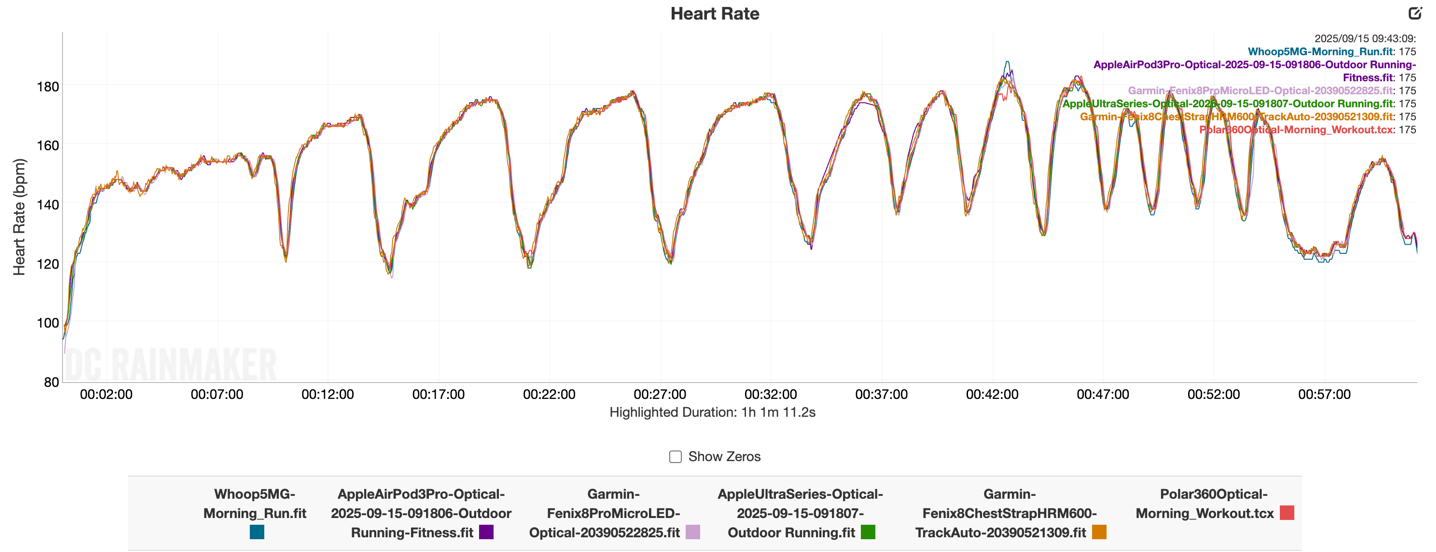
Holy crap that’s good. And frankly, good by everyone. Only one minor blip from the Whoop 5.0/MG and the Polar 360 band on one of the intervals for no obvious reason, but otherwise, spot on by everyone. I fully expected the AirPods Pro 3 to fail here, and it aced it.
Note that if you’re looking for some lifting/gym sets, I recommend you check out DesFit. Note that lifting/gym is frankly one of the easiest things you can do with something like the AirPods Pro 3, because your head isn’t bouncing/moving/etc much (if at all), and the heart rates in lifting tend to be quite low in comparison to other cardio-focused activities. Where you’d see potentially more complexity would be a CrossFit-type scenario, where you’ve got lots of quick movements and shifts in intensity. Though from a HR processing standpoint, it’d be similar to the intervals I did above.
In any case, I’m blown away. Like, legit blown away. Not because Apple couldn’t do it, but because the PowerBeats 2 Pro were so bad (and only about 8 months ago), that I’d kinda written off Apple’s ability to get optical HR correct. Further, other companies recent attempts (e.g. Polar’s with Sennheiser), have also been pretty darn bad. All of which tracked with numerous other companies over the years trying, and failing, horrifically.
Apple has managed to do something that really nobody else has: Produce a pretty solid heart rate sensing device in your ears. It’s not absolutely perfect, but it’s really strong. Plus, despite urban legends to the contrary, chest straps are rarely perfect either (especially in the cooler fall temps, when there isn’t quite as much sweat, you’ll see issues in the first 5-10 mins).
(Note: All of the charts in these accuracy sections were created using the DCR Analyzer tool. It allows you to compare power meters/trainer apps, heart rate, cadence, speed/pace, GPS tracks, and plenty more. You can use it as well for your own gadget comparisons, more details here.)
Wrap-Up:
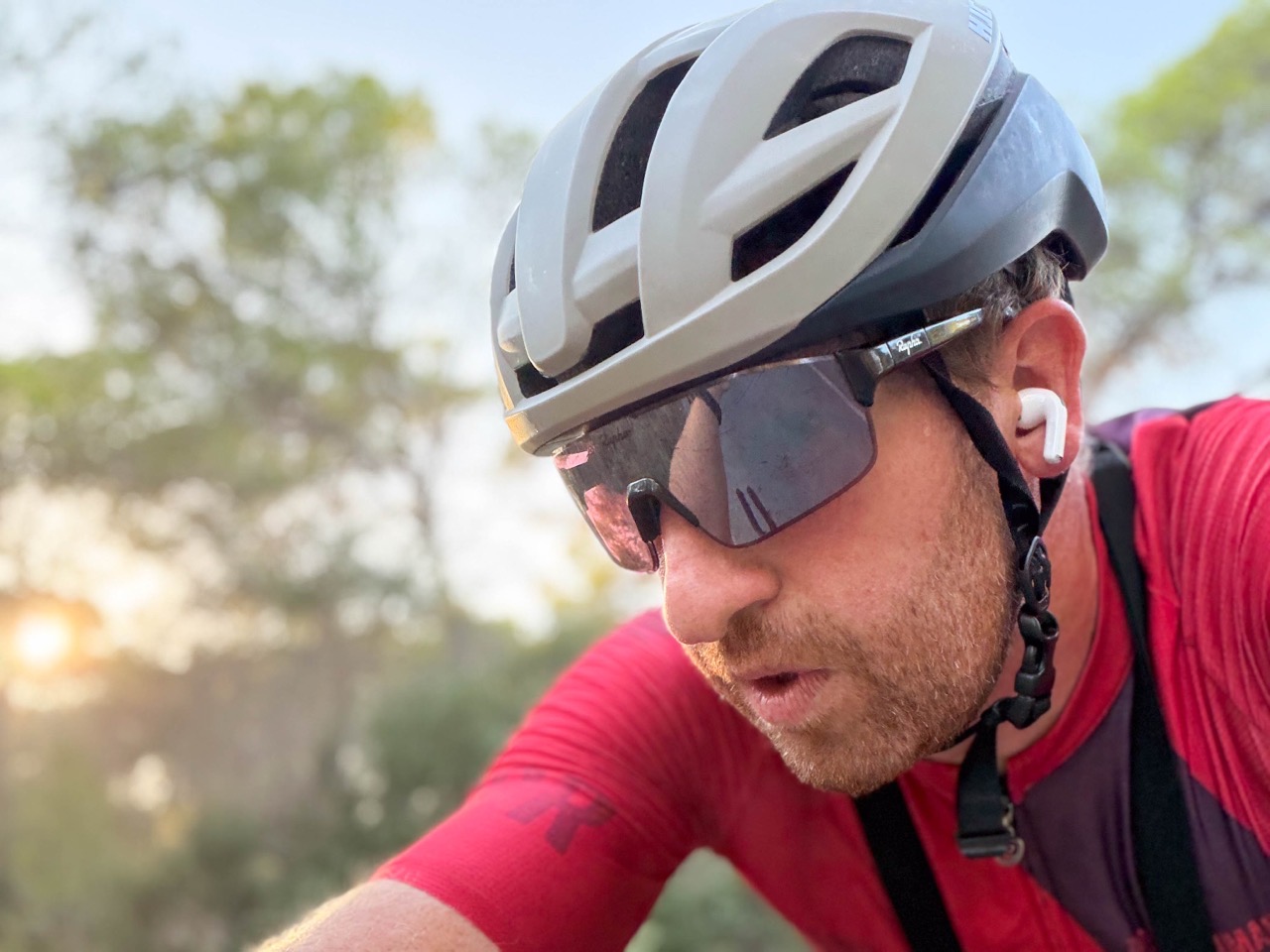
As I said above, I’m impressed. Super impressed. Partly because no other company has succeeded here, or even come remotely close. And partly because Apple was so far away from success back in February, to come full circle to a very solid product is most unexpected. At the same time, it has all the other bits that I use daily in my previous AirPods Pro 2 units that both my wife and I bought last time they came out. They’re great, and entirely my daily drivers.
That said, I really wish Apple hadn’t yanked out the standard Bluetooth HR sensing profile. This seems pretty counter to a wide array of people using the device for fitness purposes. Even the simple and common use case of a Peloton Bike (for HR) is broken here. There are 5 million Peloton users, who are also Apple iPhone users. These people largely aren’t converting to Fitness+ (because they would have done it already), so meeting them where they are seems like an easy solution for increased sales. The same goes for other cycling and non-cycling platforms that want accurate HR data, but can’t really leverage Apple’s (mildly wonky) API’s for accessing that on the Apple platform (limitations the PowerBeats 2 Pro don’t have).
In any event, if you want great sound for workouts with great heart rate, this seems like not just the easy button, but frankly, the only button. No other heart rate-capable headphones have been anywhere near this accurate (or even usable for that matter). And this seems to check both the accuracy and audio boxes.
With that, thanks for reading!
Found This Post Useful? Support The Site!
At the end of the day, I’m an athlete just like you looking for the most detail possible on a new purchase. These posts generally take a lot of time to put together, so if you're shopping for the Apple AirPods Pro 3 or any other accessory items, please consider using the affiliate links below! As an Amazon Associate I earn from qualifying purchases. It doesn’t cost you anything extra, but your purchases help support this website a lot.
And of course – you can always sign-up to be a DCR Supporter! That gets you an ad-free DCR, access to the DCR Shed Talkin' video series packed with behind the scenes tidbits...and it also makes you awesome. And being awesome is what it’s all about!


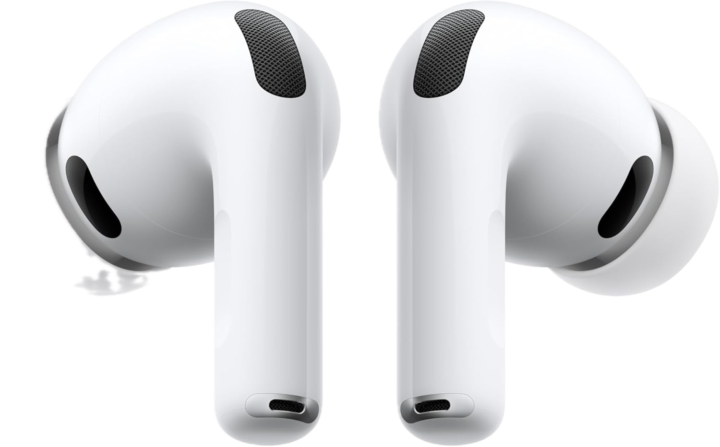













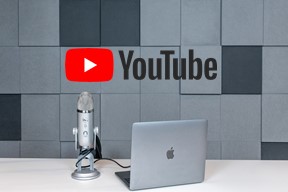

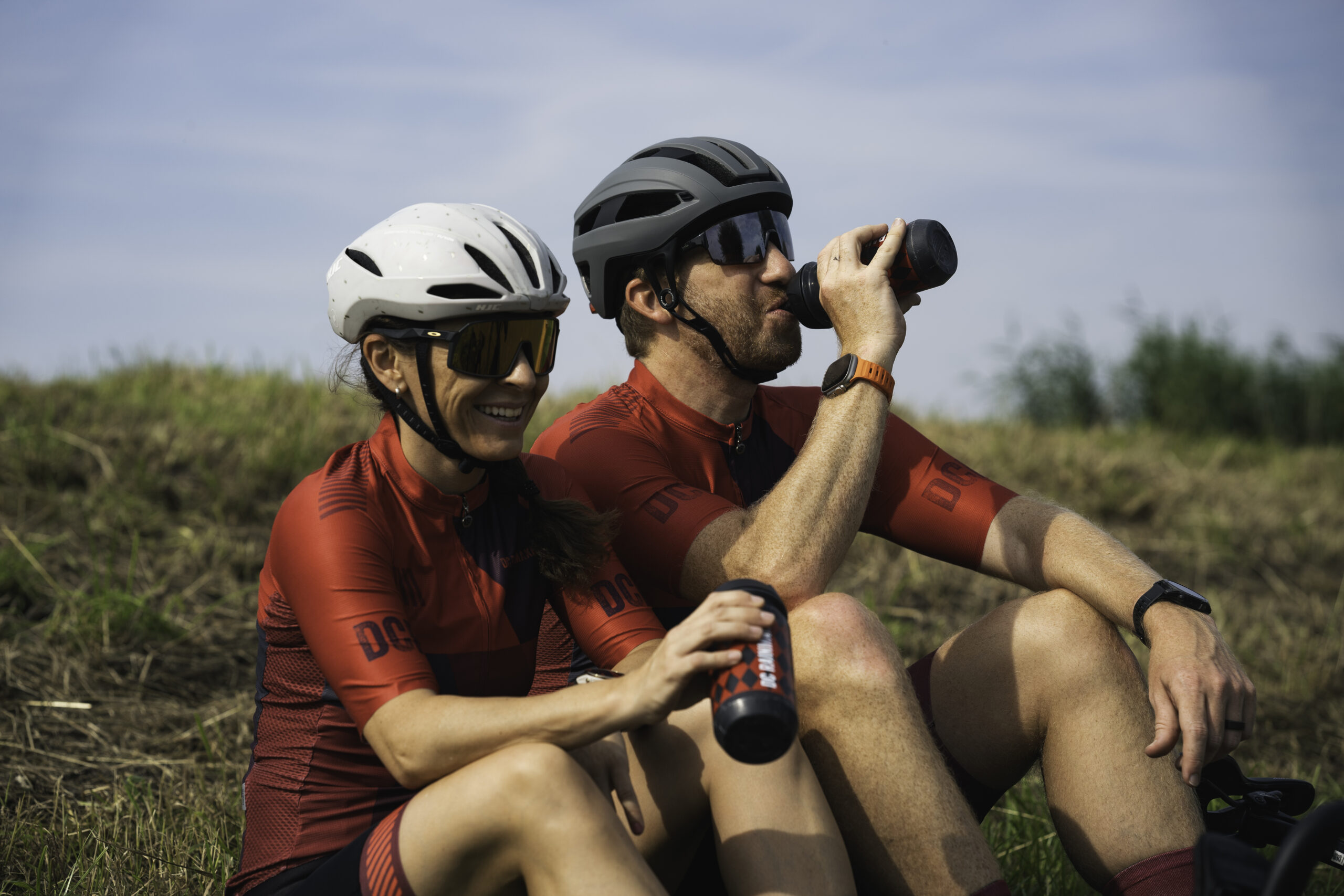

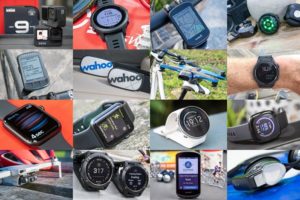

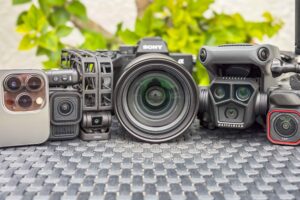

Wonder if this means Apple may be able to fix the HR issues on the Powerbeats Pro 2 as well through a firmware update, or if the actual hardware in those is just inferior to the AirPods Pro 3…?
Pretty different tech (green LED’s on PowerBeats Pro 2, vs infared on AirPods Pro 3), so uncertain there.
Theres been an update to the powerbeats pro 2 recently that has improved the heart rate tracking but I still think you cant listen to music while measuring heart rate with the powerbeats.
They announced firmware updates to the PBP2 that supposedly target improvement in HR tracking as well as add some features from AirPods Pro 2/3 to PBP2…
“Here are more improvements coming to Powerbeats Pro 2 with iOS 26, according to Beats:
A single Powerbeats Pro 2 earbud can be used for heart rate monitoring during workouts.
Powerbeats Pro 2 count steps taken when your iPhone is not on you.
Powerbeats Pro 2 and Apple Watch can simultaneously provide heart rate data.
Siri Interactions on Powerbeats Pro 2 will let you nod your head yes, or shake your head no, when Siri asks if you want to answer an incoming call, hear a text message, manage notifications, and more.
A new algorithm offers faster heart rate reading.
A notification will prompt you to potentially improve the fit of your Powerbeats Pro 2 to improve heart rate reading.
The latter two improvements will extend to Android.” – MacRumors
I doubt it will work as well as the different hardware in APP3, but perhaps it at least will get better?
Can you please test if the updates to PBP2 improve the heart rate tracking?
thanks for this in depth review Ray. sounds like they nailed it. typo (maybe?) in the live translation section
“The demos I’ve seen first-hand were all at very slow spoken speeds, and very god there”
Should be “good” ?
Good catch, thanks!
I read that when running with the AirPods Pro 3 and an Apple Watch, Apple will dynamically pick which of the heart rate data it thinks is most accurate between the two devices and use that best data in evaluating the workout. Did you see or validate that? Thanks for the awesome review.
In my case, I kept it on a separate phone, so I can validate the accuracy of it individually.
It’s definitely an interesting thing to consider testing, though I’m not entirely sure how I would know which source it was coming from (in terms of data validation).
If you dig into Apple Health and look at the individual recordings for HR, does it identify the AirPods differently from the Apple Watch?
Perhaps, and it would be a bit anecdotal, you could wear two Apple Watches with the APP3 connected to only one of them and then do something that often creates difficulty for Apple Watch HR tracking? If you saw obvious and extended issues with the watch without APP3 and then saw improvements with the watch that also had APP3 connected it might help demonstrate that Apple really is analyzing for the best quality?
Perhaps similar to what Garmin does with their ‘source switching’ option?
hi, do you think that the hr from the airpods can be used with the garmin’s app?
Garmin’s phone app won’t connect to 3rd party HR sensors from within the app, just to the device as a screen mirroring sorta thing.
Would the strave app connect to the AirPods?
Kind regards
Ray, from an audio perspective, you’ve got me a bit confused. I get that you state that most of us won’t be able to tell that the sound quality is better (which tracks, as the Pro 2s have great sound), but in the intro you state that the 3 has vastly improved noise cancellation while later in the review you call the ANC “pretty good”. Knowing you haven’t been on a plane with them yet, can you tell a significant difference between them and the prior generation?
Funny, Apple actually did a demo on campus where they recreated a plane with a set of 4 HomePods to recreate a jetliner (astoundingly loud), and there was a notable difference between AirPods Pro 2 and Pro 3. But at the same time, unless you compared them back to back, I’m not sure most people would notice.
Whereas, 6-7 screaming young girls around will challenge any ANC, because it ‘breaks’ through what it’s able to contain more easily than jet engines.
It’s really easy to notice the sound difference from the Pro 2’s. Significantly better.
So happy for the increased water rating. I sweat _alot_ during workouts, and killed multiple AirPods Pro 2s (among other “fitness” buds/headphones)… the only viable solution I’ve found has been the Shokz OpenRuns so far :/
Hi Ray,
when you mention “Expanded Fitness app to include live recordings of workouts (AirPods Pro 3 unlocks much longer list of workout types)” is it only for AirPods Pro 3 or would the unlock work for any HR sensor?
For the HR — are both earbuds required, or can you wear just one? If you can wear just one, does it matter which?
I second this question:) I generally run with friends and would consider wearing in one ear if HR worked…
Yes, you can use either one. I haven’t done full accuracy testing within the one-ear mode, though DesFit did a few tests of swapping back and forth mid-workout, and it held perfectly.
“If you can wear just one, does it matter which?”
Obviously, the correct Dad Joke answer is: The Right one.
You’re welcome….
👏
Do you think they could add Bluetooth HR Sensing profile in a firmware update? Or is it it a hardware thing?
> These infrared sensors look at the blood-flow in your hears
‘Hears’?
Technically not wrong, but probably not the word you wanted. 😁
Can you please check if the ear tips from the 3 can be used on the 2? With the foam and the new XXS size, the ear tips from the 3 could be beneficial for us that own the previous generation.
When Sony did this on the WF1000X m4 the foam was the main difference in noise cancelling. They were backwards compatible as Sony use the industry standard connection and the NC was much better on my older XM3 version when I swapped them.
At a certain point algorithms are useless unless isolation improves, hence the foam.
Worth a mention that many report fatigue with the foam after a few hours compared to silicone and I now keep the XM3 with silicone as my comfy pair and the XM5 as my NC pair. They’re both good but the NC is noticeably better with foam.
I imagine Apple will be similar and Ray’s report seems to confirm that.
Yes, I buy too many pairs of headphones!
Everyone reading this has a smartwatch. What is the use case for an in-ear HR sensor?
Agreed. Possibly opens up other users though. Don’t even need a watch to record a run. Maybe even something of a response to Whoop
Good question. Maybe for sports where you don’t want to wear your watch. But what sports? Weightlifting?
It’s hard to listen to podcasts on a smartwatch. Easy with AirPods.
I ordered 3’s, will arrive Friday. HR wasn’t even a consideration. I’m glad it works, but I’ll probably never use it. For me, it was the extended hearing aid life (audiologist has been bugging me to get hearing aids for years) and the better fit (we’ll see). My 2’s were constantly falling out.
If it’s true that when wearing both Apple Watch and AirPods Pro, that the system will select whichever dat source is most reliable, then this is useful for certain modalities where the wrist is problematic. For me that is dumbbell workouts, indoor rowing and some HIIT bodyweight work. Currently for these I use a Polar H10 chest strap connected to the Apple Watch as a more reliable signal. Some people dislike chest straps, or are hesitant to buy an additional HRM when the Apple Watch tends to be pretty good. For someone like Ray who wants the AirPods for non-fitness uses, it may have some additional benefits in these problematic modalities.
It just opened up Fitness+ on-screen metrics to anyone without an Apple Watch, and as good as Fitness+ is, I think it’s got a whole lot more to come.
Maybe Apple faced the same tech limitation as Beats that meant no Bluetooth broadcasting while listening to music -HR or music, not both – like not being able to use the car radio while driving.
Instead of dealing with that bad press they just withdrew the 3rd broadcasting functionality entirely
Although I’m still surprised Beats didn’t get beaten over the head more about that. Plenty of (second rate) reviewers don’t even mention it
It seemed like the chipset they selected wasn’t up to the task or whatever. But their watches (and countless other companies) can do it just fine. Polar/Sennheiser can do it (ignoring the fact the underlying HR is bad) especially because the HR goes on the low-power side.
Still odd. But yeah, a bummer more reviewers didn’t test it well.
I’m not defending all reviewers here, but in their defence many will be reviewing the audio side which you don’t cover much. I’d rather have one good audio review and one good sports review than see people mess with reviews they don’t understand.
Of course, then there are the others who say they’re amazing either way, copy the marketing and hype it for clicks…
As usual there’s no HR broadcast to third party devices which is a total bummer.
To be fair, there was on the PowerBeats Pro 2 earlier this year, which is why it’s odd they took it away here.
Can you comment on wind noise? Even with ANC, most earbuds are useless at speed due to wind noise. I keep buying Beats Flex headphones because the buds are low profile and I don’t need to turn the volume up to deafening levels.
Since the HR data seems to be good, it would be great if you could select your HR source, either from the watch or Airpods. This would be a way to get longer battery life out of the watches.
Brilliant review, as always.
And you saved me a couple hundred bucks, because I’m in the Peloton cohort, and I’m not spending almost $300 on a device that I can’t integrate into all of my workouts. I wonder what the engineering challenge was that resulted in this.
This is Apple, it’s rarely engineering challenges stopping them it’s usually design decisions. Apple tend to avoid implementing hard stuff and concentrate on making what they have very good. It’s a double edged sword, it often means they lack features, but also means their products are more polished.
It’s $249 retail and it’s quite easy to get them for much less. Like $199.00. Even the new ones.
“Avoid implementing hard stuff”? Is this a joke? Hard stuff like accurate in-ear HR measurement? Live translation? Apple Silicon?
Great article. Couple of typos here:
These infrared sensors look at the blood-flow in your hears, and measure the movements of said blood. This data is then feed into a whole slate of algorithms
Thanks!
Could the HR be used in Zwift when connected to a Mac or an iPhone with the companion app? Thanks
Wondering why I’d buy these for the HR functionality. I have an Apple watch but you say the HR doesn’t broadcast to the watch for a more accurate HR??
Hi Ray, can you please confirm that the heart rate is actually measured by Air Pods. I read that if you were Apple Watch the recording of heart rate defaults to it…
Correct, it’ll use sensor fusion in that case.
Which…is why for all my testing I had the AirPods paired to a secondary account on a secondary phone, unconnected to my Watch.
Ah the sensor fusion sounds potentially good!
I love my apple watch and my airpods, but since I always have my apple watch recording HR I have been wondering what possible benefit there is to having HR in my airpods (and doesn’t almost everyone who wants HR and can afford airpods already have a smartwatch?).
If fusion works well enough to pick up drops and help say the two devices get an HR lock faster – that would be great! Although does it do that well? It sounds like they just “pick the best source” rather than combine with some more fancy ML/signal processing or get the two things to talk to each other to help find a lock …
Like any sensor I know I get the odd drop especially early in a run. So fixing this with two sensors doing beautiful apple-eco system stuff would be fab :).
Not sure if I missed it, but can 3rd party apps (Trainerroad, etc) on your iOS device received the heart rate data from the headphones?
Would also love to know the answer!
According to the video from Chase the Summit, its some proprietary heart rate feed Apple is using here. There’s an API available to developers, so it sounds like its on the app developers to add support for it.
I really hope these dont pick up random environmental noises when on the phone…I would turn the faucet on (or open a bag of chips) and people I am talking to would freak out because the airpod pro v1 would take that sound and amplify it like crazy. Also hope the HR broadcast gets added in the future via SW update. Would be nice for my indoor workouts..
Is the HR sensing always on, or just during recorded workouts? And what’s the battery drain? I was wondering if these would work similar to a watch, with always-on HR that you could glance at on your phone and maybe be passively recorded by the Healtg app for daily trend info, etc.
Will the HR function work with third-party tips? I use a pair of memory foam tips on my 2d Gens and would like to keep using them 🙂
It should, as the HR function is outside of the tips, along the side of the unit.
Just to clarify, if you are an iphone user with a garmin watch and do all fitness tracking via garmin…then the heart rate functionality is useless? Or am I misinterpreting?
Correct.
Oof. Dealbreaker.
I have a feeling that Apple has had to resort to taking the raw sensor data from the headphones and doing the algorithms (as Ray says this is the secret sauce to getting accuracy) on the phone rather then on device. Which is why the AirPods don’t broadcast the derived HR data and why it is not available to 3rd party apps either.
A really insightful comment, would be interested to hear if Ray can ask Apple more on this.
If you’re right Apple could have broadcast the HR over BT from the iPhone but it seems didn’t want toZ
I appreciate you making sure that you only get data from the AirPods, not the watch, but in my use case I would have both. I would love a test, maybe with one AirPod in one ear, connected to the same Account as an Apple watch on your wrist and then in the other ear an AirPod connected to a different account and a second Apple watch also separate on the other arm. That way we would have a comparison between the combo vs.each device on its own. The test sounds like a huge hassle, but exactly the thing you would do. Anyways, appreciate the review!
So if you had to choose only one of PowerBeats Pro 2 or AirPod Pro 3 for daily use and sports use combined…? That’s my dilemma and ima sure lots of peoples – be great to have just one but is either feasible for that?
I can say something about this. I bought my PowerBeats Pro 2 earlier this year to replace my aging AirPods Pro 2, and my 3’s are arriving Friday (still in the “preparing to ship” phase, but there’s a big Apple warehouse in Carlisle, so it won’t take long). I bought the PowerBeats because AirPods can and will fall out. I don’t use anything for cycling. (Back when Coros made helmets, I had one with built in bone conduction speakers. Wind noise easily drowned them out.) I’ve used the PowerBeats once or twice for hiking, although I prefer my Shokz OpenRun for that. For skiing I’d use the OpenRun, never something small and white that can fall out, or even something small and orange that could get pulled out by a branch or pop out in a fall.
I don’t use the HR from the PowerBeats. It’s recorded, and if you look at the raw HR data in Health, you can tell that it gets recorded at times. But I read/watched the reviews, and I know it’s not accurate. I’m glad that HR works in the 3’s, but I doubt again that I’ll ever use it, because I already have chest straps and optical devices that I’ve accumulated over the years, in addition to the HR sensors on the watches. AirPods are good headphones, and both the PowerBeats and AirPods do the “automatically attach to the device you’re paying attention to” (which isn’t always what you want). But for HR? There are better and cheaper solutions available. These are good headphones with extra tricks, but you shouldn’t buy them for the tricks.
For me, it’ll be largely a benefit for indoor rowing on Fitness+ so that I don’t have to wear my Watch Ultra or a cold chest strap.
Are you going to keep the PBP2s or go with the APP3 only?
I’ll continue to use my PBP2, at least for a while. I want to make sure that the 3’s actually stay in as advertised. I wanted the 3’s because they have a hearing aid mode which the PBP2’s don’t. I’ll probably continue to use the PBP2’s for dog walking and the occasional hike, anytime where it would cause trouble if an AirPod fell out, but I’ll probably use the 3’s for most other things. On the other hand, I’m not going to carry both and the AirPods case is smaller, so they’ll probably always be with me.
Kudos to Apple for getting in-ear HR working! 🥳
Now, I just hope and pray they don’t have a patent that means no-one else can 🫣
IR sensors at 250 Hz? You know they do.
I am a bit confused about when the HR functionality can be used. Obviously it works with an Apple watch / iphone using their fitness app. However, would it also work for indoor cycling with zwift on an Apple tv (the only real usecase for cyclists I reckon)?
Or is the bottom line that this only works with Apple build software apps?
“For running, it was good, though still a bit of wind noise when the wind blew in certain directions.”
Would you say it is a significant improvement over the Airpods Pro 2?
– No broadcasting of heart rate on standard Bluetooth HR profiles, like there was on PowerBeat 2 Pro
– And thus, no gym equipment/fitness machine support, like there was on PowerBeat 2 Pro
And that is why we need A LOT MORE REGULATION FROM THE EU :)
I will not buy them. That one-way-compatibility by Apple is intentional, they want grab the data and users but lock-out everyone else.
“I let them dry a bit, and they were good to go. No issues since then, and all is good. Which makes sense, because again, on paper, that’s literally what it says they support.”
Honestly, I would disagree… swimming and stuff is not covered by the IP rating, because moving them around in the water drastically changes the pressure and is totally different from simply lying in water in a certain depth. Sure, they are definitely overengineered… but saying that the IP rating supports swimming is imho wrong.
“The majority of Garmin bike computer users are on iPhone.”
Do you have any data that supports this? Or are you talking US only? Considering the iPhone’s low market share in the rest of the world, I find that very hard to believe.
The removal of HR broadcasting is also a deal breaker for me. Unless there is a technical reason, I’m guessing Apple have made the judgement that they will not lose many sales from us fitness people, as we will already have HR monitors in other watches or straps. On balance, they may expect to make more sales across their range of devices (phones, watches) by locking new/ more casual fitness consumers into their ecosystem. I’ll continue to use my Bose earbuds, iPhone, Suunto watch and Polar HR strap in various combinations depending on the use case for the foreseeable!
Don’t ride a bike with any kind of headphones on.
Did you do any testing with just the Air Pods Pro 3 just connected to the watch? for music or other wise?
Measuring heart rate while swimming is notoriously difficult – I didn’t see where you talked about the results of the HR monitor in water – only that it worked.
How was it?
You can’t record the HR, as discussed, the signal drops out to the phone immediately (as expected). My point in testing the water was to show the water resistance aspects.
I missed that bit – reading comprehension was never my strong suit.
Thanks for follow up!
Would the pro3 be able to get heart rate if using a single side?
When Riding on road or on the MTB I only use the right side to keep one ear open.
Yes, either side individually can be used, including for HR.
Thank you!
HR accuracy excellent. Great, I’ll upgrade from my Pro2s.
Oh, can’t send HR to Garmin. I guess I’ll keep my Pro2’s.
From a sports tech pov the fact that these don’t broadcast HR over Bluetooth to any 3rd party device means they’re useless to anyone who has been training for enough time to have meaningful data in their chosen platform, which ai imagine is most of your readership. While it’s technically interesting the HR data is good, if I can’t use it where I need it, it just doesn’t matter. As such I don’t understand why this feels like a broadly positive review.
Another commented asked about this I think, but I’ll echo it here: if you’re wearing the AirPods Pro 3 and not an Apple Watch, will the AirPods periodically record background HR and write it to Apple Health the way the Watch would normally do? And contribute to Rings as well? Might come in handy for when one is charging the watch.
I’m one of these who could not keep the AirPods 1 inside their ears. Especially one of the sides. This is why I’ve steered away from them.
Kept running with the beats – awesome fit, nice audio.
Did anyone that was prone to losing them from their ears tried the 3rd gen?
Got mine Friday. They’ve fallen out a couple of times. I should probably try different tips, since I switched to the large size when I took them out of the box. They do feel more secure than my 2’s/
AirPods Pro have never fit me – nor any Apple earbuds for that matter. I have those little add-on rubber wingtips for all my corded Apple buds. I took a chance and got the 3s and I’m really happy with them, right out of the box with the default tips! No movement, no slippage!
I think the slightly oval shape and different form are what does it. I can rotate them slightly to lock in. I compared them with my Work-issue AirPods Pro 2 and the difference is significant. Even with the Comply foam tips on my 2s, the stock 3s are significantly better.
Hopefully you have the same results if you decide to give them a shot!
It’s a bummer that air pods pro 3 cannot broadcast heart rate. However since the buds can pair to other devices maybe it could heart rate data, those are tiny bits unlike sound.
“That said, I really wish Apple hadn’t yanked out the standard Bluetooth HR sensing profile. This seems pretty counter to a wide array of people using the device for fitness purposes. Even the simple and common use case of a Peloton Bike (for HR) is broken here. There are 5 million Peloton users, who are also Apple iPhone users. These people largely aren’t converting to Fitness+ (because they would have done it already), so meeting them where they are seems like an easy solution for increased sales. The same goes for other cycling and non-cycling platforms that want accurate HR data, but can’t really leverage Apple’s (mildly wonky) API’s for accessing that on the Apple platform (limitations the PowerBeats 2 Pro don’t have).”
Yeeeeeees!